With the commencement of each new school year comes a series of changes. Reflection on the past year sparks an idea for a change— something to improve the community. Over the past summer, the administration decided one change would be a wooden container with twenty-four different slots for students to place their phones in before the start of every class—a cell phone “cubby.”
Head of Upper School Mr. Mark Fifer said, “One of the pieces of feedback and undercurrents that we felt last year was that, particularly in academic spaces, the presence of cell phones was getting in the way of the learning objectives and connectivity in classes.”
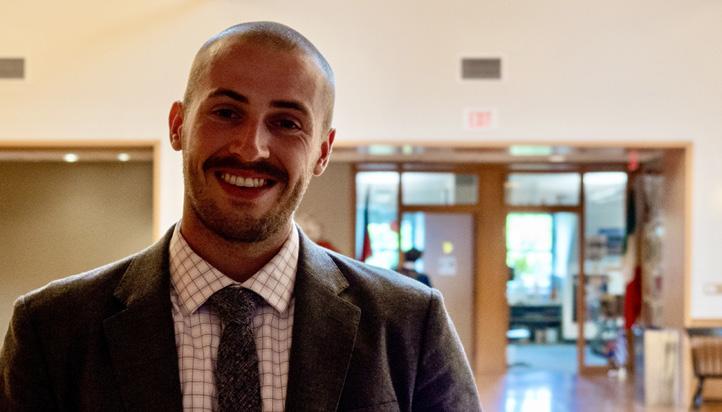
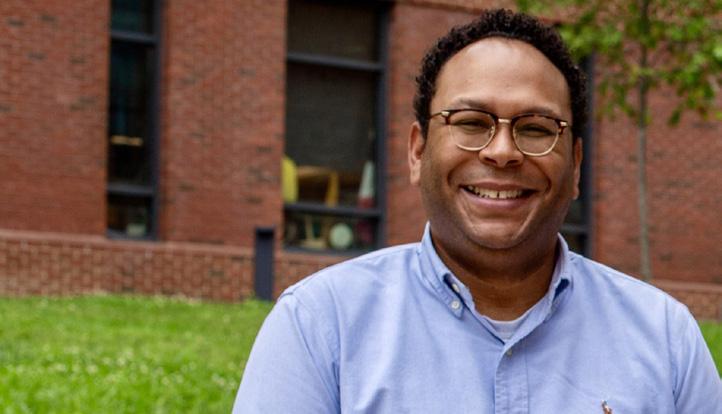
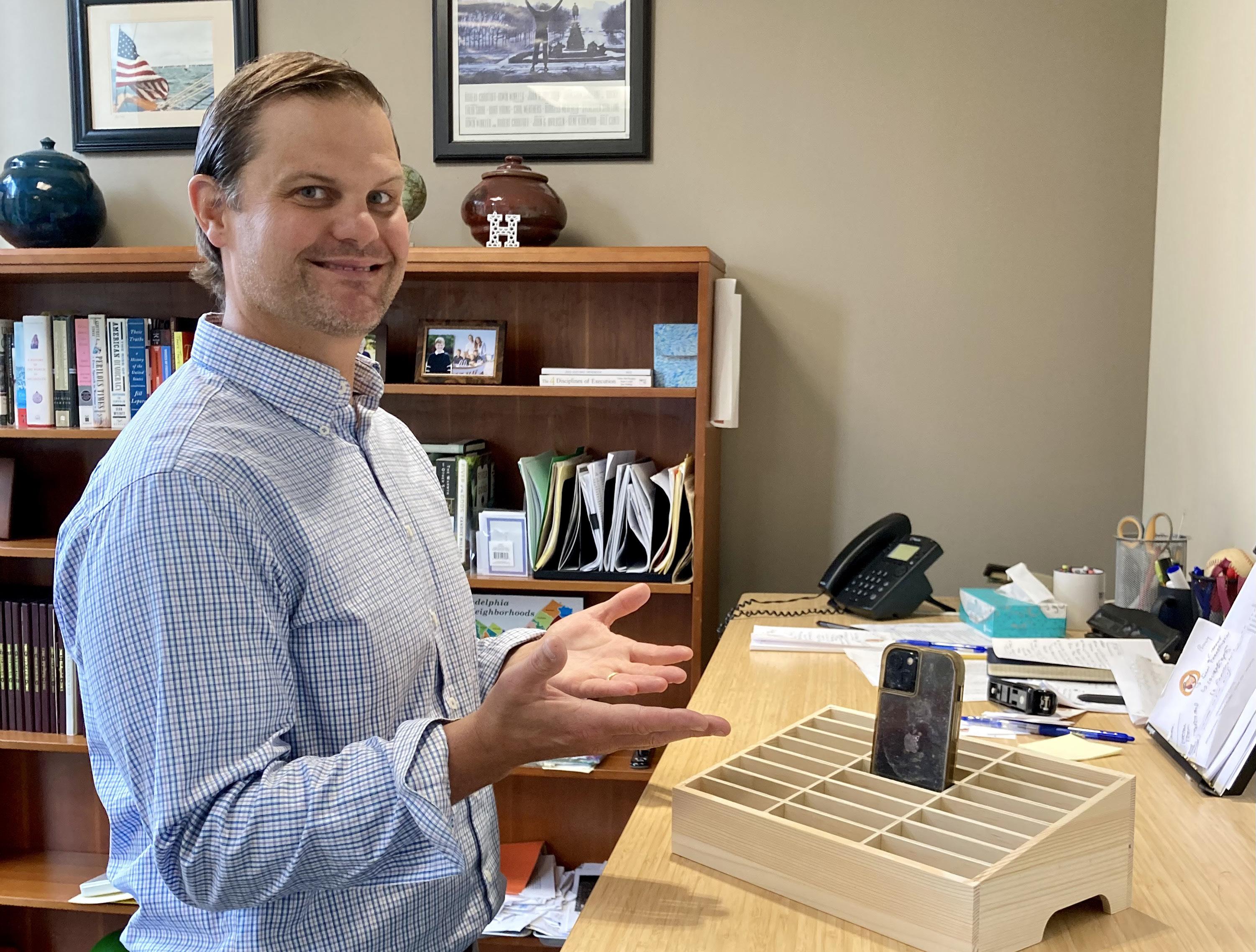
Students will place their phones in the cubby at the beginning of class, and, at the end of class, they’ll be able to take them back. However, the policy also extends to outside of the classroom. Phones will not be allowed during Academic Support Block or in dining hall lines, hallways, or Centennial Hall, a policy that was heavily pushed last year. Phones are only allowed when students are in the pods, the Big Room, the library, outdoors, or in the Community Room.
con’t on p. 3
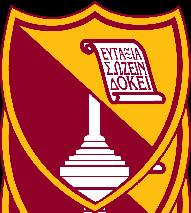
Administration looks to drive engagement by restricting cell phones
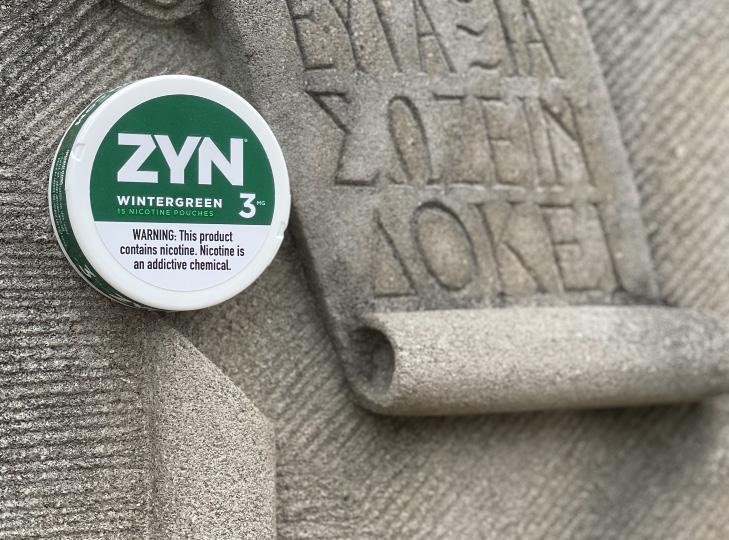
Captains set the tone for soccer season
milan
The Fords soccer team is known for its winning tendencies, strong leadership, and, most of all, its camaraderie, all of which make it a unique and formidable team on and off the pitch. Most know that a team is only as strong as its leadership. The captains for the 2023-2024 year are Sixth Formers Thomas Kaplan, Connor Cresswell, Jackson Raleigh, and Sebastian Perez-Gasiba.

As captains, the bar needs to be set high. Especially with a team made up of some incoming Third Formers and JV players who move up to varsity, it is important for bonds to be formed to perform at the highest level.


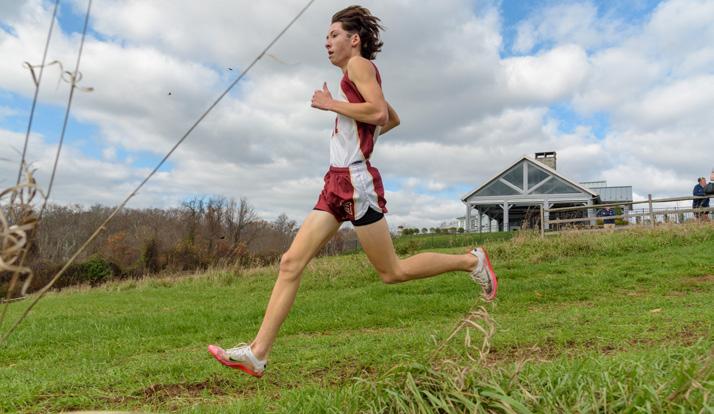
To do this, the team starts training and prepping for the season early. During the last few weeks, all members of the team have been hard at work training, doing tryouts, and even their first game on September 1st.
“In the summer I’d try to make sure that I was running, usually in the mornings, and just getting out and playing a little soccer,” Kaplan said, “and I’d go in a group sometimes too.”
“I stay physically and mentally prepared by just playing as much as possible at my position,” Cresswell said.
con’t on p. 15
INDEX STAFF
The
19041 · September 2023 · Volume 91, No. 1 · thsindex.org the index The student voice since 1888
Mr. Fifer with a new cell phone “cubby” on August 25, 2023
Haverford School · Haverford, PA
Football, p. 15 DR. MIKE NANCE Mr. Rob Moore, pg. 7 PIERCE LAVERAN ’24 Cross country, p. 16 COMMUNICATIONS Mr. Jeremy Branch, p. 5 MS. KRISTIN BROWN
varma ’25
Casey Williams ’24
DR. MIKE NANCE
Connor Cresswell ’24 and Thomas Kaplan ’24 in a 1-0 win over Penn Charter last October
the index
2023–2024 Staff
Ethan Lee ’24
Editor-in-Chief
Adiyan Nayak ’24
Editor-in-Chief
Christopher Schwarting ’24
Editor-in-Chief
Arsh Aggarwal ’24
Senior Managing Editor
Casey Williams ’24
Senior Managing Editor
Ian Rosenzweig ’25
Managing Editor
Connor Simpkins ’25
Managing Editor
Milan Varma ’25
News Editor
Tate Conklin ’24
Features Editor
Elliot Lee ’25
Academics Editor
Ryan Hu ’26
Junior Academics Editor
Tripp Ronon ’24
Neighborhood Editor
Luke Ganley ’25
Campus Opinions Editor
Abdullah Kanchwala ’25
Campus Opinions Editor
Grayson Morgan ’26
Junior Campus Opinions Editor
Talan Maury ’26
Off-Campus Opinions Editor
Tommy Saul ’26
Off-Campus Opinions Editor
Russell Yoh ’24
Arts Editor
Liam French ’25
Junior Arts Editor

Charlie Keidel ’24
Sports Editor
Quinn Sullivan ’25
Junior Sports Editor
Pierce Laveran ’24
Senior Photography Editor
Riyadh Rolls ’26
Junior Photography Editor
Luca Aloi ’25, Sean Ngo ’24, Sam Pennington ’26
Staff Writers
Ms. Emily Harnett Faculty Advisor
Mr. Thomas Stambaugh
Embrace authentic interaction editorial
Welcome back.
As we begin the 20232024 school year, we urge you to keep an open mind in the classrooms of Wilson Hall. Much will be made of the new cell phone policies, and rightly so, as the restrictions are a departure from the previously lenient approach to cell phone usage. What we hope, though, is that valuable dialogue will not turn to conflict.
We do not want to tell you how to feel about the restrictions. Regardless of your
stance, though, we hope that the student body can use this as an opportunity to engage with each other on a personal, authentic level.
Student leaders and recent Sixth Forms have worked to foster a culture of unconditional support and community engagement. While it is easy to feel frustration towards authority, we encourage you to instead seek meaningful conversations and true connections on the campus. We talk endlessly about brotherhood–what it means, why it matters,
how to achieve it. Genuine interaction is the foundation of the brotherhood we idolize.
As we navigate the academic year ahead, consider taking advantage of the time away from our screens. Embrace the opportunity to connect with your peers on a deeper level, fostering relationships that transcend the digital world.
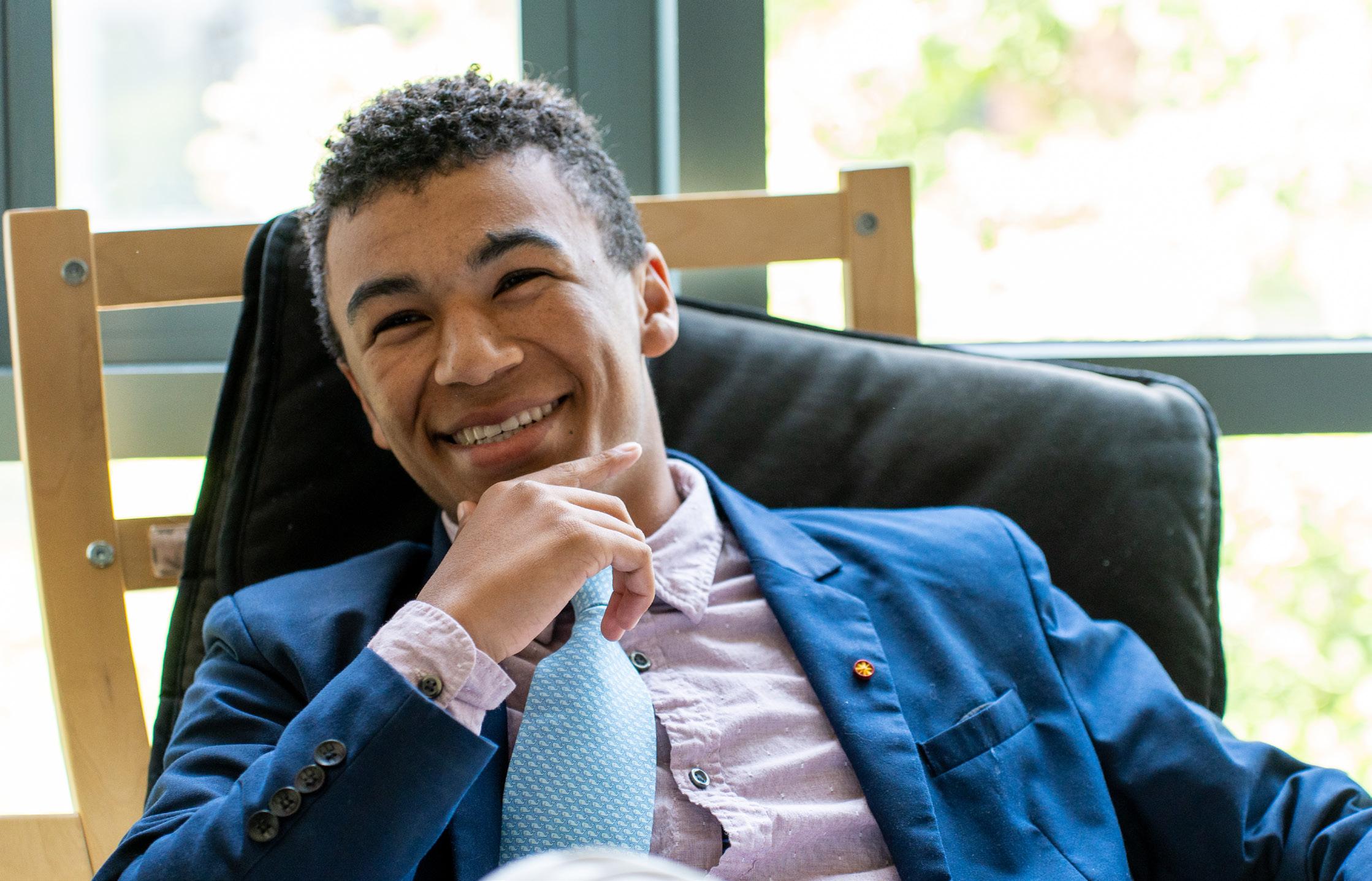
Let us all carry with us the spirit of unity, respect, and genuine connection that defines our community. Be bold, be true, and most importantly, be connected.
Letter from the student body president
I would first like to take this opportunity to thank you all. You guys put a lot of trust in me by electing me as president, and I do not take this responsibility lightly.
I hope this letter finds you rejuvenated and ready for another great academic year. With the beginning of a new school year there comes a unique opportunity. Now’s the time to set new goals, try that different club, or learn from past experiences. Whether this is your first time walking through these halls
or you are a lifer, you are all key members of this family we call Haverford. Together we will create memories and leave a legacy that lasts a lifetime.
I would encourage you all to take this opportunity to challenge yourself, whether that be in the classroom, during an extracurricular activity, or simply challenging the normalities in your life. Reflect on how you go about things and why. Not only are we just members of this community, but we all have the opportunity to be change-makers in this space. There is no perfect way of doing anything, but there is a wrong way, and that’s
doing nothing.
Take control of your destiny. Stay disciplined throughout the arduous journey that is a full school year. There will be ups and downs but the downs are what make you a better person. The struggles of your past are essential to who you are today, so embrace them.
Remember, success is a journey, not a destination.
I cannot wait to see what this year holds, and every single one of us has the opportunity to make this year special! Thank you and Godspeed.
The Index is a student-run publication of the Haverford School that does more than bring news: it provides the diverse perspectives of the Haverford student body. It is an outlet for student writers to take stands on issues they deem important. It chronicles the daily struggles and accomplishments of the Haverford community. The Index also provides a forum for discussion of pertinent issues, such as student culture, academic policy, and Haverford’s place in world affairs. The Index presents new ideas and aspires to influence constructive change. All opinions and viewpoints expressed herein do not necessarily reflect those of The Index or the school. The Index is designed and produced digitally. Photographs may be retouched. Submissions and letters to the editors regarding any and all articles are welcomed at index@haverford.org The Index, a member of the Columbia Scholastic Press Association, is composed using the applications of Google Suite and Adobe Creative Cloud. Its surveys are conducted via Google Forms and are advertised on email to current Haverford students. Graphic designs are created by Index staff via Canva. Southern Dutchess News prints 200-400 copies of each issue, and its editorial staff distributes them in the Upper School on the day of release. The Index serves the needs of a total school population of 1152 community members, consisting of 952 students and 200 faculty and staff members. Contact The Index 450 Lancaster Ave, Haverford, PA 19041 index@haverford.org Twitter: @Haverford_Index Instagram: @Haverford_Index Volume 91, No. 1 - September 7, 2023 September 2023 Page 2 the index · editorial
Faculty Advisor
2023-24 Editors-in-Chief (left to right, Adiyan Nayak ’24, Ethan Lee ’24, and Christopher Schwarting ’24)
Hello Fords,
Asa Winikur ’24
PIERCE LAVERAN ’24
Cell phone restrictions, cont. from

“I noticed a great improvement in Centennial Hall [after phones were restricted],” Mr. Fifer said. “It helped us to drive some of the objectives that we wanted. We wanted to create a time to fully come together and build community without the distraction of devices.”
As of now, the presence of cell phones will only be permitted during two specific time periods: eating lunch and during free periods.
“Free periods are probably the best,” Dean of Students Mr. Luqman Kolade said. “It makes the most sense. There’s no other time otherwise, really.”
One major source of concern from the student body was the possibility of an emergency, and students needing to contact their families at home.
“If there’s ever an emergency such that the parent needs immediate contact with the student, then contacting the upper school office is always available,” Mr. Fifer said. “A lot of the research that I’m reading suggests that these devices result in higher levels of distraction, perhaps because they’re smaller and easier to access.”
Part of that research was a survey conducted last year to Haverford students that suggested a direct correlation between the amount of time spent on technology and student unhappiness.
“It’s stupid,” Sixth Former Adon Gross said. “I get it, people will be on their phones too much, but the thing is, some people… have things like attention deficit disorder, and you need something to calm you down.”
Gross also feels that students are educated enough to know when they need to put away their phones.
said. “I’m on social media, but I’m very anti social-media in the sense that there’s a lot of negative that it adds to our lives.”
Sixth Form Dean and Spanish Teacher Ms. Brooke Kenna echoed a similar sentiment.
“It’s very liberating, because you’re more present,” Kenna said. “We do use technology, I think we just need to be much more intentional about the way that we do it.”
The faculty all seem to be on the same page as for how the phone policies will be used, and the positive effect that it might entail.
“I can still listen, and if you’re showing something on the board, then I’ll put my phone away,” Gross said. “It’s not like I have music blasting in my ears.”
Others feel that the upper school already has a strong enough community, and the cell phone policy might be excessive.

“Coming from multiple schools, Haverford’s more engaged than any other that I’ve been to,” said Fifth Former Sebastian Gillis. “I feel like it could be bad because it might get a lot of people in trouble, plus Haverford’s already pretty engaged.”
However, others support the policy and the positive changes that it might bring.
“Growing up, I always went to overnight camp. I always thought that not having my phone for an extended period of time was very peaceful,” Student Body President Asa Winikur said. “So I’m in support of it. I think there’s going to be growing pains, but over time I think it’s only for the benefit of everyone because we’re going to interact more with each other and be more engaged during class.”
“The message from the whole upper school is that this is how we’re going to do things from now on, so the expectation is that when you walk into a classroom, your phone goes into that cubby no matter what,” Ms. Kenna said. “From time to time, I’m going to have [my students] pull out their phones and record [for assignments], but the expectation is that they go back immediately.”
A large reason for the restriction of the cell phones has been due to the overreliance on the devices, and teachers have witnessed that firsthand.
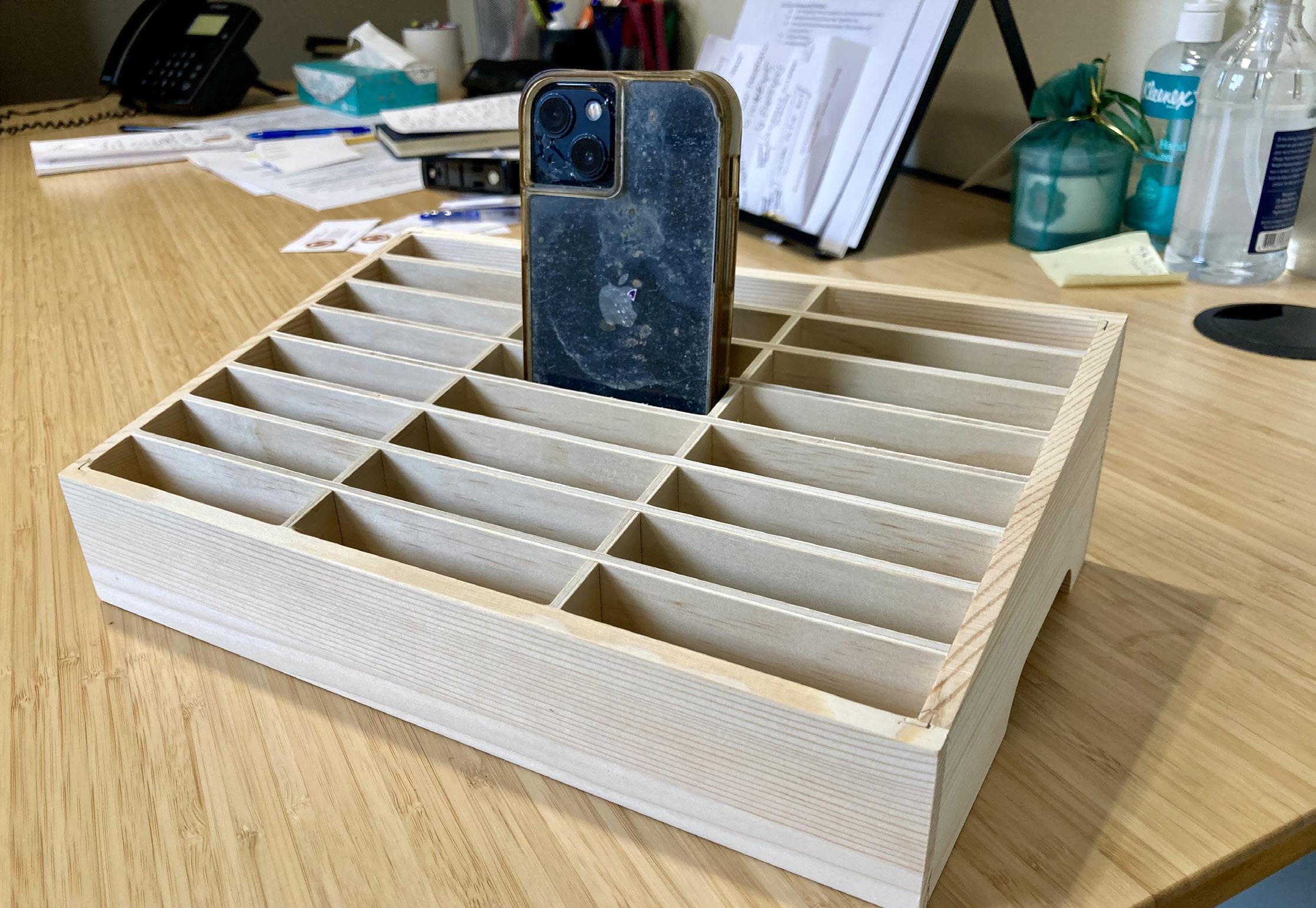
“Sometimes it was just the furtive check-
“I think this is a part of a larger objective to try and teach the healthy use of technology and devices,” Mr. Fifer said. “We’re just trying to drive learning, engagement, and connectivity, and there’s a lot of compelling research out there that suggests that [cell phones] just don’t do that.”
“We looked at the survey that we did last year in which there were some really clear data points that established a correlation between the amount of time that students were spending on social media apps, and their own self-reported ability to manage their time, self-reported connection to the school community, and their self-reported ability to meet their academic obligations,” Mr. Fifer said. “So in reflection, we felt as if we needed to think about the boundaries that we were putting in place regarding access and use of smartphones in classroom spaces.”

As for how students are reacting to this new change, many are upset.
Winikur also stated that he’s seen phones, and more specifically social media, hindering student experiences.
“It’ll be eight hours of the day where you don’t have to worry about what’s going on in the social media world,” Winikur
ing when I’m in the middle of a lesson or activity,” Ms. Kenna said. “Sometimes you’ll walk through the lunchroom and there’s ten kids sitting together, but they’re not talking with each other, they’re all on their phones.”
According to the administration, the primary goal of this new policy is to improve the school’s environment, and strengthen the community.
Cell phone cubby in Mr. Fifer’s office
front page
“So in reflection, we felt as if we needed to think about the boundaries that were putting in place regarding access and use of smartphones in classroom spaces.”
INDEX STAFF news the index · news September 2023 Page 3
MR. MARK FIFER
“I can still listen, and if you’re showing something on the board, then I’ll put my phone away.”
ADON GROSS ’24
“Sometimes it’s just the furtive checking when I’m in the middle of a lesson or activity.”
MS. BROOKE KENNA
Robotics team renovates lab over the summer
After years of planning, the robotics team finally made their dream a reality: a renovation of the robotics lab. Over the summer, screws and nuts found a new home in the classroom down the hall while the robotics room transformed.
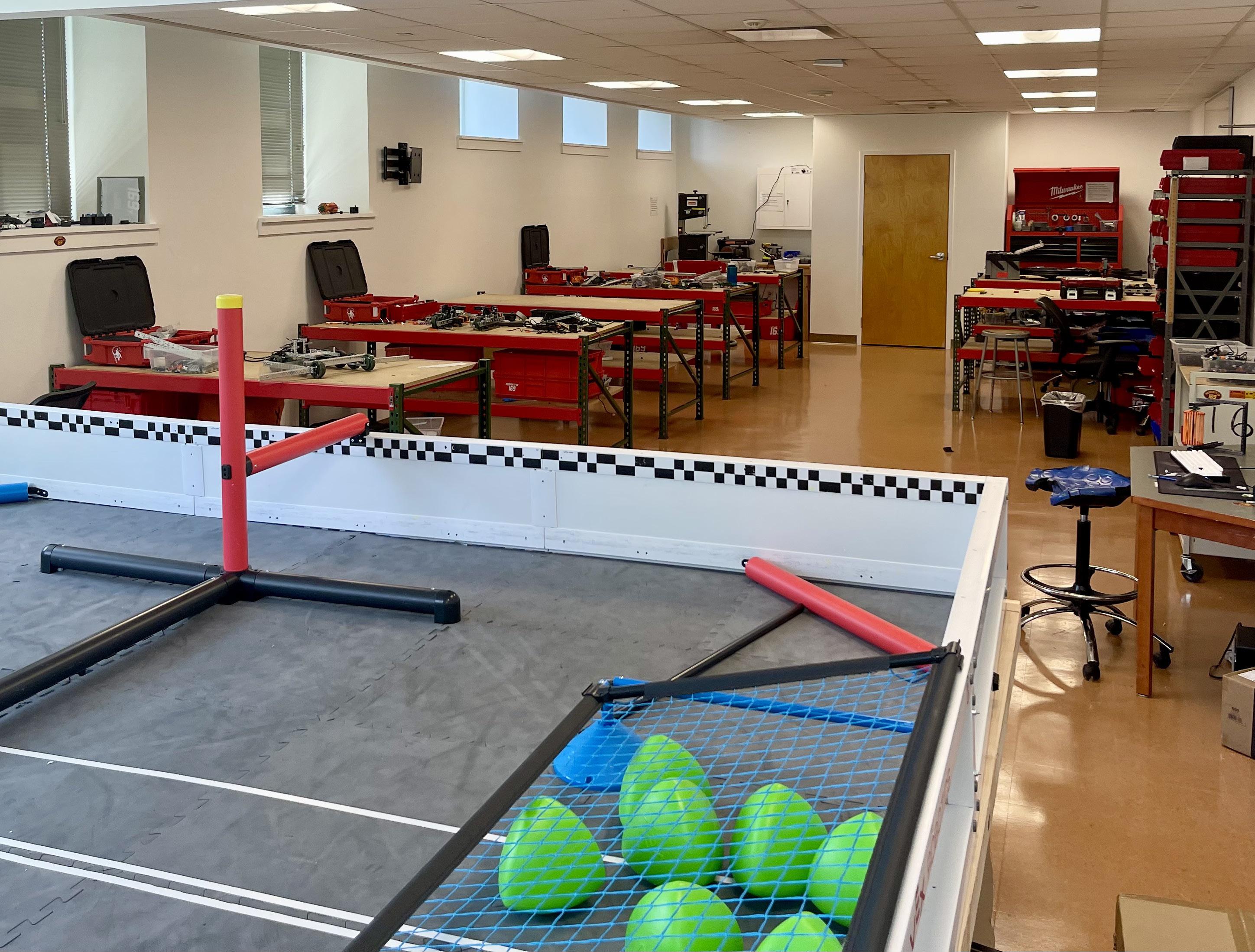
Robotics coaches Mr. Will Leech and Mr. Adam Myers have been waiting for this moment for a long time.
“We have been asking for renovations for as long as we have been in this room,” Mr. Myers said. “The vision of the school for a long time was that they wanted to keep spaces as pliable as possible, and this renovation made this place more devoted to robotics.”
Mr. Leech and Mr. Myers had two goals for the renovation.
“We came in with some simple requests. Carpet gone and hopefully the walls gone as well, which has let us get more flexibility in
how the room was organized,” Mr. Leech said.
They reached out to Facilities Director Mr. Jeremy Wilkinson around early April, who solidified the request by the end of the school year. Around July, contractors arrived, and they finished the renovation by early August.
The coaches were delighted with the result.
“We’re thrilled. It’s going to make a real impact on the culture of the robotics team. Having a dedicated space and having it or-
ganized will relieve some of the stress off our shoulders and of the members of the team,” Mr. Myers said.
“The difference between what was achievable versus what we wanted was small, and we’re really grateful that our needs were met,” Mr. Leech said.
The coaches also designed a large wooden platform to replace the standard one sold by VEX, the company responsible for the robotics competitions.
“It was really a financial decision. Two thousand dollars for a standard VEX field,
Bridge Program connects new students to the Haverford community

versus five hundred for some lumber from Home Depot. It’s more specialized than a cookie-cutter VEX field and opens up more opportunities to send more teams to competition,” Mr. Leech said.
Robotics team members are excited about the upcoming season and the new space.
“The old robotics room seemed to be like this thing stuck in the 90s, now it seems more modern and functional than before,” Fifth Former Kevin Covington said. “It seems free.”
Dean of Students Mr. Luqman Kolade agreed.
“The intent is to form connections, to help students begin the process of knowing one another, upperclassmen student leaders and to feel comfortable from the first day of
During the last week of June, rising Third Formers new to Haverford were invited to campus for the annual Bridge Program, a fourday orientation run jointly with the Agnes Irwin School. The long-standing program is designed to ease the transition to a new school, help boys get to know one another as well as girls from AIS, and become familiar with the school campus, faculty, administra-
tion and upper school leaders.
This year, the program consisted of a day on campus and three days on Agnes Irwin’s campus.
The first day, students met with members of the Signet Society, Honor Council, and other important student body organizations. They also took campus tours, met faculty, and familiarized themselves with many of the community’s customs and
traditions.
“Meeting the new guys during Bridge is the beginning of a relationship with upperclassmen,” Honor Council Chairmen, Signet Society member, and Sixth Former Luke Feznak said. “They will see us up on stage at the beginning of the year’s activities, on the fields, and in the halls throughout the year, so it’s good to get an early introduction.”
school,” Mr. Kolade said.
Additional faculty member participants included Ms. Brooke Kenna, Mr. Brian Long, and Mr. Timothy Lengel.
While Bridge has existed for years, programming has evolved. Once primarily an academic-based orientation, the focus is now on community building and connection. In addition to fun activities like bowling, there is also a community service component. This year, students volunteered with Cradles to Crayons.
Over twenty boys participated in the program this summer, and Mr. Kolade believes that the benefits of participation are long-standing.
“It helps foster relationships early, you will find guys talking about Bridge years after participating,” Mr. Kolade said. “I see the benefits, on the first day of school, when boys who are new to the school walk in and immediately start talking and walking around with the guys they met at Bridge. This is what Haverford is—it is all about the relationships.”
ARSH AGGARWAL
’24
The renovated robotics room, September 4, 2023
Elliot Lee ’25
Third Formers during the 2019 Bridge Program
MS. SARAH LEONARD Connor Simpkins ’25
“We have been asking for renovations for as long as we have been in this room. This renovation made this place more devoted to robotics.”
the index · news September 2023 Page 4
MR. ADAM MYERS
“It helps foster relationships early, you will find guys talking about Bridge years after participating.”
MR. LUQMAN KOLADE
spend one-on-one time with each student on individual projects in the studio,” Mr. Boyer said. “It’s really fun to see students grow and allow their concepts, ideas, and craft to grow before your eyes.”
Outside of the classroom, Mr. Boyer enjoys athletic pursuits and exploring.
“I was a four-sport athlete in high school and played soccer in college, so I have a relationship with sports, [in addition to] the occasional hike and taking the train up to see shows in New York City,” Mr. Boyer shared. “And of course, spending as much time working in the studio as I can is important.”
Sometimes, the world’s technical hubbub can render perceptions of the arts as secondary.
Mr. Christopher Boyer to provide mentorship in the artistic process
After serving as a Teaching Assistant and Adjunct Professor at the Tyler School of Art and Architecture in Philadelphia, Mr. Christopher Boyer joins the Art Department, focusing on teaching 2D art.
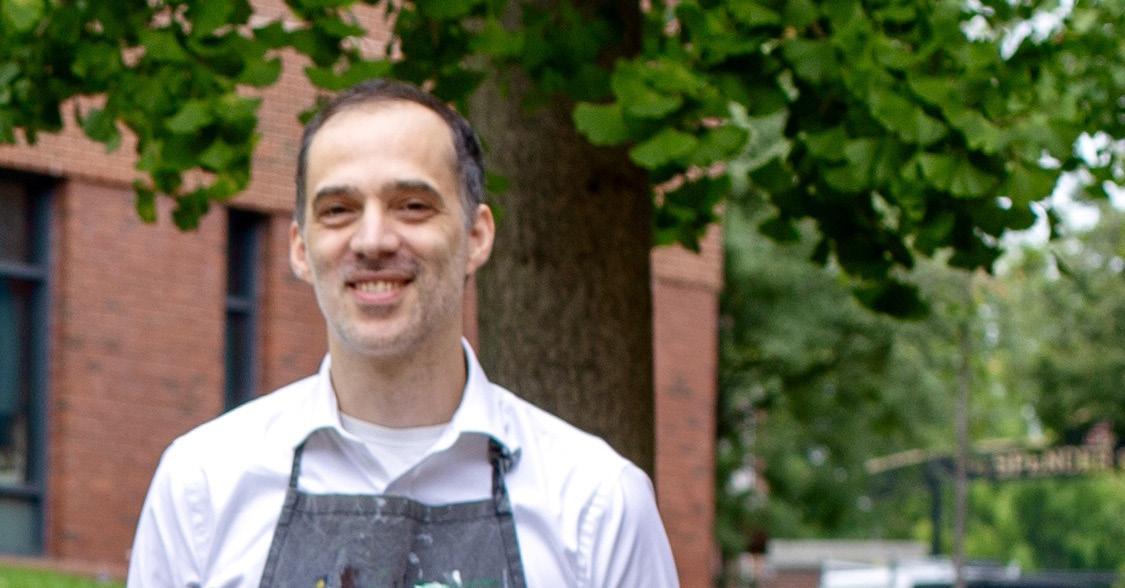
Mr. Boyer brings over a decade of career experience to the upper school’s art studios.
“Before grad school at Tyler, I was an artist living and working in New York City for about ten years,” Mr. Boyer said. “I worked in art studios mostly in Brooklyn and Queens—producing works for other artists and myself for shows in New York and
all around the world. It’s exciting to bring that knowledge to my students.”
Mr. Boyer recalls some of his first moments experimenting with 2D art while in high school.
“I think about my time painting in high school and my art teacher giving us a bucket of oil paint and saying: ‘have at it.’ I want my students to just get involved with the material—with the nature of oil painting,” Mr. Boyer said.
Mr. Boyer sees mentorship as a foundation for arts education. While completing his B.S. in Painting at Indiana Wesleyan
Mr. Jeremy Branch to advocate for his students
After spending more than five years as the Senior Assistant Director of Enrollment Management at Penn State Brandywine and fifteen years in admissions at Pennsylvania State University, Mr. Jeremy Branch joins the college counseling office’s experienced staff as an Associate Director.

Mr. Branch joined the Penn State admissions office shortly after graduating from the university.
“I was intrigued by the opportunity to work closely with students and parents as they navigated the stressful and robust college-search journey,” Mr. Branch said.
He also knew, from experience, how stressful the process could be.
“My own college search was chaotic yet successful, so I knew what families were up against and that I could help,” Mr. Branch said.
However, he was surprised at how much he enjoyed the work.
“If you would have told me seventeen years ago that I would eventually become the President of the Pennsylvania Association for College Admission Counseling and a Board Director for the National Association for College Admission Counseling, I would have laughed in your face,” Mr. Branch said.
During his time working at Penn State, Mr. Branch had many opportunities to visit Haverford.
“The young men were always a joy to
work with, and The Haverford School as a whole seemed to have a vision, unique vibe, and culture that stood out to me,” Mr. Branch said.
University and his M.F.A. at Tyler, mentor relationships played a key role in developing his craft.
“I am still friends with my professors from my undergrad years, and that kind of mentorship is something I’ve understood as such an important thing for me,” Mr. Boyer said. “Building those [relationships] is what I aim to do here.”
Mr. Boyer will direct his students with a similar appreciation for mentorship and forging connections, building on his experience as an Adjunct Professor at Tyler.
“The key to each class was getting to
The school’s dedication to artistic practice is among the features Mr. Boyer admires about the community.
Mr. Boyer will guide his students through art as a process—learning lessons applicable both to their craft and their conduct as people and problem-solvers.
“Art is not about a perfect product from the beginning. It’s really about learning to fail so that you can grow and learn to problem solve,” Mr. Boyer said. “It’s a huge journey.”
And as Mr. Boyer begins that journey with students, he wants them to remember their goal as artists: to grow.
“No one knows anyone’s potential,” Mr. Boyer said. “It’s all about a growth mindset for me.”
When the opportunity arose, Mr. Branch seized it.
“For a long time I knew that The Haverford School was one of the only schools that I would even consider leaving College Admissions for,” Mr. Branch said. “I was waiting for the right opportunity. This opportunity.”
Mr. Branch brings years of experience to Haverford’s college counseling office.
“One [lesson I have learned] that comes to mind is the importance of establishing and maintaining strong relationships with my students, my colleagues on campus, and my colleagues at other institutions,” Mr. Branch said. “In order to help a student to find the right “fit,” a college/university that is right for them particularly, the stronger the
relationship [between student and counselor], the better the outcome will be.”
Mr. Branch plans to be a strong advocate for his students during the admissions process.
“Developing and maintaining relationships with colleagues at other institutions will help in finding that right ‘fit,’ [in addition to] staying on top of the shifting trends and challenges that may impact our students and opportunities to advocate for our boys,” Mr. Branch said.
Outside of his work in college counseling, Mr. Branch is passionate about many
other activities.
“Faith. My family—my wife Laia, my son Brooks, and our dog Penny. I love watching all sports. I love playing golf. I’m obsessed with music. Star Wars and Marvel are everything. The beach,” Mr. Branch said.
Mr. Branch is excited and optimistic about the upcoming school year.
“I am so excited to work with my Sixth Formers and their families, my colleagues in the College Counseling office, and to attend as many games as possible across all sports,” Mr. Branch said.
Elliot Lee ’25
Christopher Schwarting ’24
Mr. Christopher Boyer
Mr. Jeremy Branch
the index · features September 2023 Page 5
MS. KRISTIN BROWN
“It’s all about a growth mindset for me.”
MR. CHRISTOPHER BOYER
MS. KRISTIN BROWN
“My own college search was chaotic yet successful, so I knew what families were up against and that I could help.”
features
MR. JEREMY BRANCH
Mr. Don Holdren to teach music, lead vocal ensembles
After a four-year hiatus, Mr. Don Holdren makes a return to the classroom. With a remarkable seventeen-year tenure at Mount St. Joseph’s Academy, Mr. Holdren embarks on a new journey as he joins the performing arts department. In his new role, he will instruct music as well as direct the Notables and Glee Club. During his time at Mount St. Joseph’s Academy, he served as a music teacher, the Chair of the Fine Arts Department, and the Dean of Studies.
“I am really excited. It’s been four years since I have been in the classroom and with students,” Mr. Holdren stated. “I was in an administrative position prior to this one, and it’s been a while since I have had that connection in the classroom.”
Because of this gap, Mr. Holdren was sure to prepare to reenter the classroom and be in front of students again.
“I did a lot of reading, and I did a lot of reflection on what was important to me as an educator and what I love about music,” Mr. Holdren stated. “It is important to me that my students learn a lot but also that they really become comfortable with expressing themselves and that they walk away with a real love of music.”
Mr. Holdren brings a wealth of knowledge and experience. He holds a B.A. in Music from Washington College and a M.A. in Vocal Performance from Washington University, as well as a M.A. in Education from St. Joseph’s University.
He also conducts local choirs and runs a private voice studio.
Mr. Holdren focuses on a studentoriented and collaborative approach to his teaching.
“Students can expect that I will show up for them, I will be authentic, and that we will work collaboratively to accomplish a goal, whether that be a concert or a project,” Mr. Holdren said.
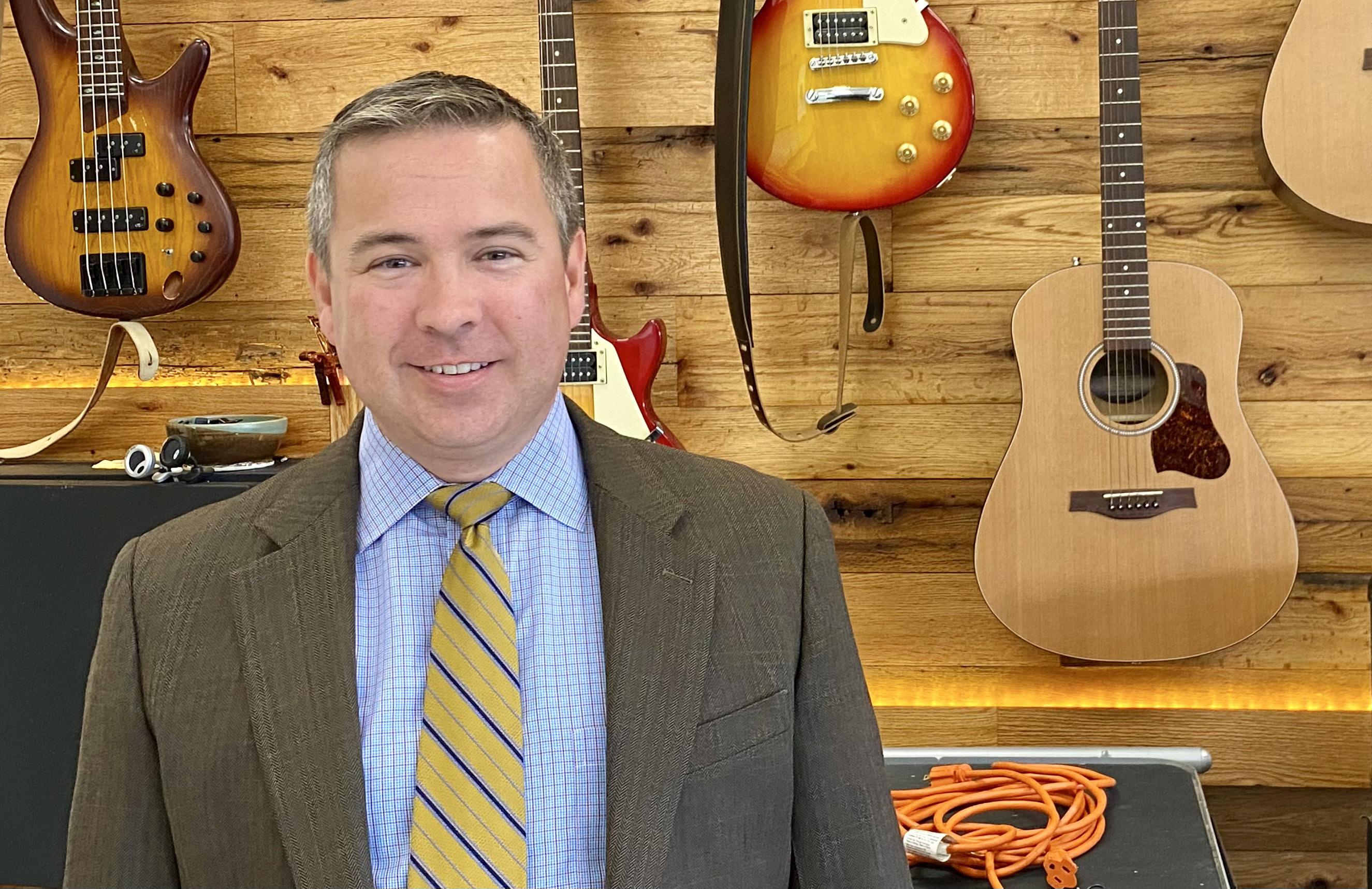
Part of what drew Mr. Holdren to Haverford is its strong focus on the student experience.
“[Haverford] is a place that is truly fo-
cused on what makes the student experience work,” Mr. Holdren said.
“What works in terms of teaching, what works in getting students to grow and become the best versions of themselves. Haverford is a very student-oriented school, and I am very excited to be a part of that,” Mr. Holdren said.
Mr. Holdren is looking forward to working with students.
“It is an honor to be a part of this community,” Mr. Holdren said, “and I am looking forward to making some really great music.”
Johnson-Hackett welcomes new families to the community
by coaching.
“Right when my playing career ended, I actually got into coaching football, which I’ve been doing now for five or six years,” Mr. Johnson-Hackett said. “I did some grassroots organization coaching out in Harleysville, and I spent the last three years coaching at LaSalle College High School.”
On campus, Mr. Johnson-Hackett hopes to support athletic teams in addition to his role in admissions.
“I’ll be lending all of my athletic talents and knowledge to [Haverford’s] athletic department. I should be helping out the football team in some capacity, as well as the track and field team,” Mr. Johnson-Hackett said.
Mr. Johnson-Hackett believes in the importance of physical activity, which guides many of his pursuits off campus.

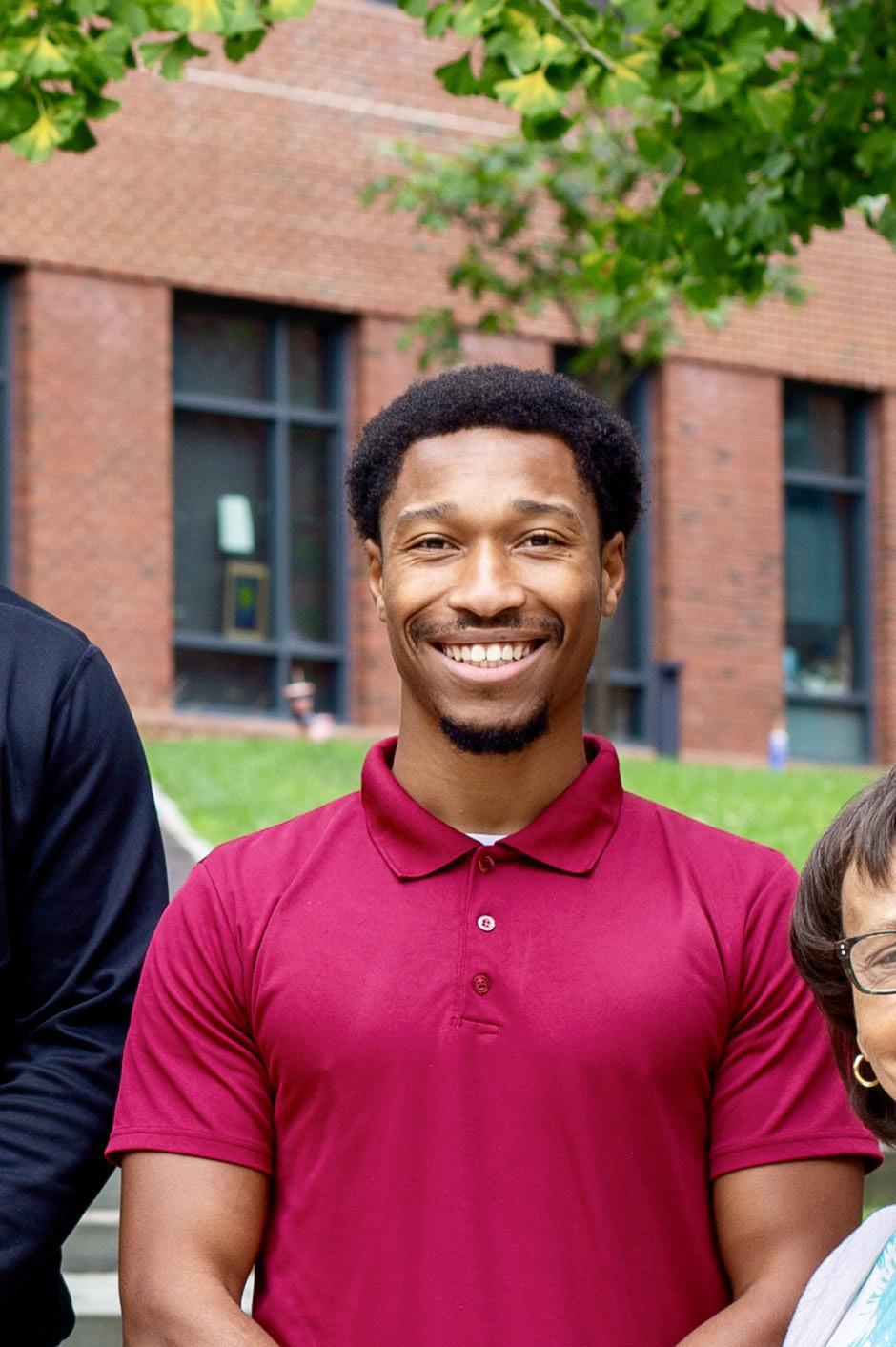
school—one of the first faces prospective families get to meet and talk to, and joining these families on their journey as they try to find the best schools for their boys.”
Mr. Kyle Johnson-Hackett joins the admissions office as Assistant Director of Admissions. A Philly local, he will help prospective middle and upper school families navigate their school search.
Born and raised in Philadelphia, Mr. Johnson-Hackett has roots in the area.
“I grew up in the Lawncrest area of Philadelphia,” Mr. Johnson-Hackett said. “I ended up at Roman Catholic [High School] for two years, then I transferred and graduated from Archbishop Ryan High School.”
Mr. Johnson-Hackett then attended Chestnut Hill College, where he majored in Digital Communications and was a studentathlete.
“I ended up playing football and running track at Chestnut Hill College,” Mr. Johnson-Hackett said.
He subsequently earned his M.S. in Sports Administration with a focus in Business from Southeastern Oklahoma State University.
As a former collegiate athlete, Mr. Johnson-Hackett continues his passion for sports
“I find myself on trails a lot. I’m really big on health and fitness—I believe health is wellness. So I’m in the gym. I also practice martial arts and have been practicing Muay Thai for about four years,” Mr. Johnson-Hackett said. “I’m definitely a dog dad, I have my baby Copper—she’s a twoyear-old. I like taking my dog out all over our beautiful city.”
Of course, Mr. Johnson-Hackett’s main priorities lie in his admissions role, in which he is excited to welcome new families.
Mr. Johnson-Hackett said, “I look forward to being one of the faces of the
And in addition to helping families, Mr. Johnson-Hackett, too, is excited to join the community.
“I hope to bring a new set of fresh eyes—the team has been nothing but warm and welcoming, as the rest of the Haverford community has been,” Mr. Johnson-Hackett said. “It’s definitely a change of pace for me, working at a place where I can feel the warmth and the love and the community. That’s definitely something I’ve been excited about.”
ADIYAN NAYAK
’24
Mr. Don Holdren
Ethan
Lee ’24
Mr. Kyle
Mr. Kyle Johnson-Hackett
MS. KRISTIN BROWN Christopher Schwarting ’24
“It’s definitely a change of pace for me, working at a place where I can feel the warmth and the love and the community. That’s definitely something I’ve been excited about.”
the index · features September 2023 Page 6
MR. KYLE JOHNSONHACKETT
“Haverford is a very student-oriented school, and I am very excited to be a part of that.”
MR. DON HOLDREN
Mr. Damian Long intends to build bridges to college
Connor Simpkins ’25
For Mr. Damian Long, the new Director of College Counseling, it’s all about the process. Coming to Haverford from Moorestown Friends School in Moorestown, N.J., where he served as the Director of College Counseling, Mr. Long is excited to join the school’s College Counseling team, a group he has known for over a decade.
Prior to Moorestown Friends, Mr. Long was the Associate Director of College Counseling at The Shipley School, the Associate Director of College Counseling at The Hun School in Princeton, N.J., and a College Counselor at Saint Augustine Preparatory School in Richland, N.J.
Mr. Long holds a B.A. in Human Services and M.A. in Counseling from Villanova University where he was also an Admissions Assistant and a Graduate Research Assistant in the Department of Counseling and Education.
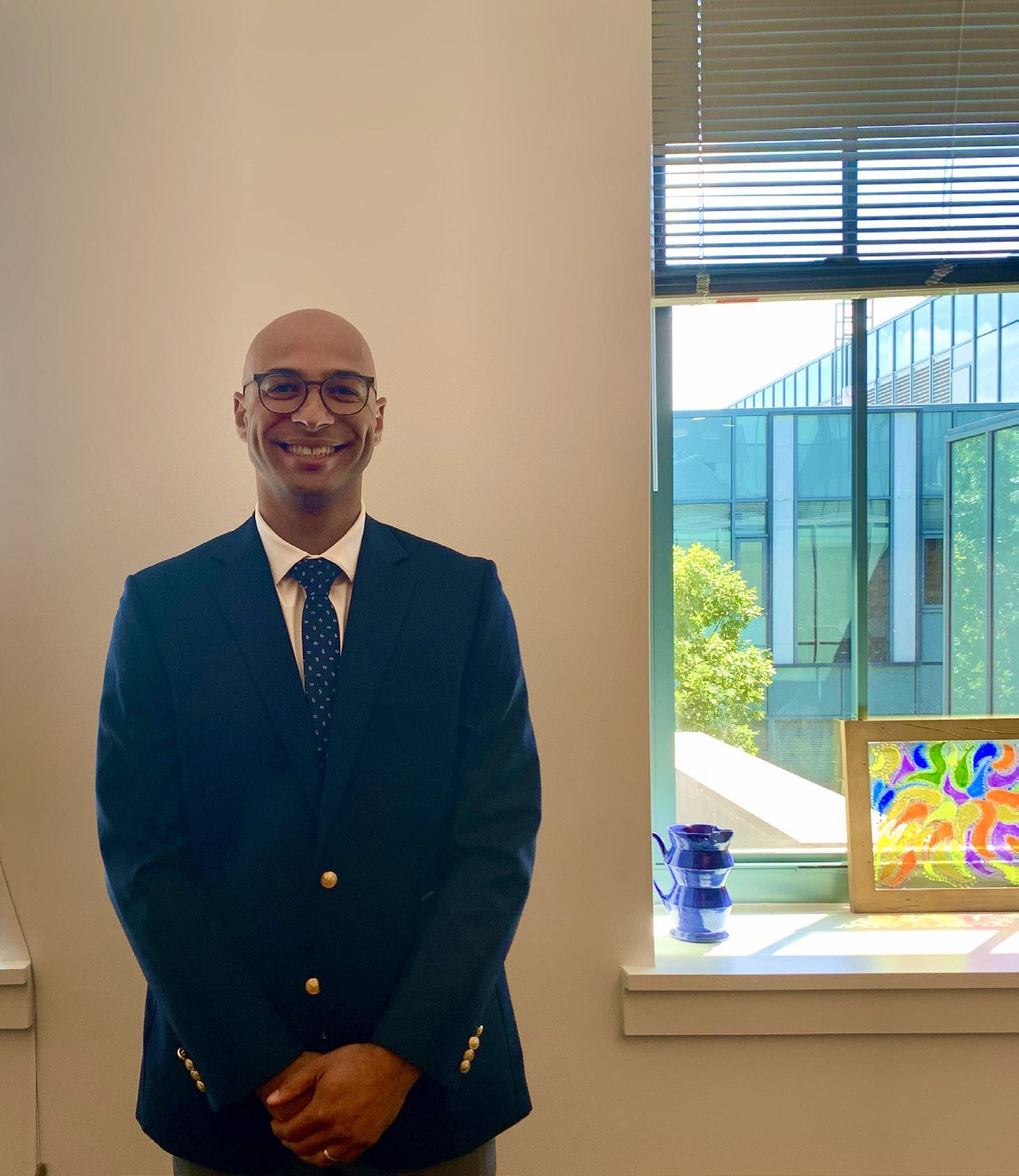
In addition to serving as the Director of College Counseling. Mr. Long will also serve as a Third Form advisor.
After becoming a father sixteen months ago, Mr. Long began reflecting on his own educational experiences and what was impactful for him.
What stood out were the relationships and the experience of being at a school with a mission to prepare boys to thrive outside the walls of the school.
Haverford’s virtue-driven culture felt like a perfect fit. In an era of heightened focus and worry about college admissions, Mr. Long is optimistic and confident.
“The [college admissions] process is so much more than just the outcomes. It’s also about the reflective practices that come with the process. It is easy to start with an outcome in mind but unpacking the why and how behind a desired outcome can be the
most valuable part of the process,” Mr. Long said. “It is a great period of self-discovery for students.”
Speaking to the challenges facing current students in the college admission process, Mr. Long pointed to the ever-changing, dynamic aspect of the college admission landscape.
“Especially after the pandemic, changes in the admissions process accelerated,” Mr. Long said. “Whether it’s the college visit or the volume of applications. There is a lot of pressure that leads to heightened anxiety.”
Mr. Long also noted an evolution in expectations.
“There has been a shift in focus, where students and families are looking more closely at return on investment,” he said. “College is increasingly being seen as a vehicle more than a destination.”
When the Supreme Court delivered its decision against affirmative action this summer, Mr. Long’s first thought was about how he could support students with the changes.
According to Mr. Long, the College Counseling office is being proactive about the changes to affirmative action and its impact on students and families.
In addition to ongoing professional development to keep abreast of changes, the team is collaborating with other independent schools in the area, including developing a webinar to address key topics.
“We are constantly evaluating, as new information becomes available, how we can share it with families so they can use it effectively,” Mr. Long said.
Mr. Long’s work is guided by a poem to which he was first introduced as student leader in college, and which will soon be hanging on his office wall.
“The Bridge Builder,” by Will Allen
Dromgoole, is about an elderly traveler who, after crossing a dangerous river, doesn’t continue on his journey but instead stays and builds a bridge over the water to ease passage for the younger travelers behind him.
“It is about stewardship, helping those who will come after us,” Mr. Long said. “As I think about my young son, as I think about the perspective of parents, which I understand and appreciate in a whole new light. I think about how we are building bridges for our children [or our students] so they can best navigate the future.”
Ms. Marla Wilson settles into Severinghaus Library
For many students, Severinghaus Library is a beloved campus study area and resource center. Part of the library’s unique appeal is the library staff, who work to make research accessible and support students throughout any range of class or extracurricular work.
This year, Haverford welcomes Ms. Marla Wilson, who joins the staff as Library Services Coordinator.
Ms. Wilson has experience working with a broad range of students and a diver-
sity of texts and resources. For fifteen years prior to joining the staff, Ms. Wilson worked at the Harrisburg Area Community College. Prior to that, Ms. Wilson served in the middle school classroom for seven years teaching language arts at a public school in Maryland.
Ms. Wilson holds a B.A. in English and an M.Ed. in Developmental Education.
Outside of school, Ms. Wilson enjoys a variety of activities. Her hobbies include baking, gardening, bird-watching, listening to music, and, of course, reading.
“I don’t have one favorite book, but I prefer to read fiction,” Ms. Wilson said. She particularly likes the Harry Potter series and Lord of the Rings, which are well-known to the Haverford community. She also enjoys The Mitford series.
As the mother of two sons, she is familiar with the needs and interests of boys. She enjoys spending time with her sons, her husband, and their chihuahua mix Georgie.
Drawn to Haverford by its “core virtues and mission,” Ms. Wilson is already enjoying her experience.
“My colleagues are amazing,” she said. “Everyone has been incredibly welcoming and helpful. I am very happy to be here.”
Ms. Wilson will also be a part of the Information Services team, a role in which she will be responsible for library and resourcefocused community programming, library purchasing and cataloging, and other administrative duties.
But as most all faculty and staff would note, the Haverford community is not complete without the students on campus. Ms. Wilson is looking forward to meeting students and has already begun planning new ideas to support learning at Haverford.
“In the very near future, I plan to create a new LibGuide for the library focused on writing resources,” Ms. Wilson said.
Both online resources and in-person support make Severinghaus Library a versatile research and study space, and Ms. Wilson is soon to be a fixture of students’ day-today academic endeavors.
 CONNOR SIMPKINS ’25
Mr. Damian Long in the college counseling office, August 31, 2023
CONNOR SIMPKINS ’25
Mr. Damian Long in the college counseling office, August 31, 2023
“The [college admissions] process is so much more than just the outcomes. It’s also about the reflective practices that come with the process.”
the index · features September 2023 Page 7
MR. DAMIAN LONG
Ian Rosenzweig ’25
INDEX STAFF
Ms. Marla Wilson
“Everyone has been incredibly welcoming and helpful. I am very happy to be here.”
MS. MARLA WILSON
Ms. Corey Revoir transitions to Assistant to the Head of Upper School
Adiyan Nayak ’24
In the upper school office, Ms. Corey Revoir will take on a new role to support the daily operations of Wilson Hall. After working as an Events Coordinator and Administrative Assistant for the past four years, Ms. Revoir will now transition to the post of Assistant to the Head of Upper School.
Ms. Revoir has ample experience in leadership roles, including in her career before 2019, when she managed a boutique and served as an executive assistant at a cybersecurity company.
“I have been in many administrative roles where you have to be good at planning, and be detail oriented, organized, and be able to see what’s coming ahead of time so that you’re able to execute,” Ms. Revoir said.
Such administrative positions have allowed her to develop essential relationship building skills, many of which were already natural to her.
“I definitely see myself as a people person, so that’s always helpful,” Ms. Revoir said. “I think I am a good listener, and you have to be a good listener to keep your relationships and still be able to make those tougher decisions. You definitely have to be able to hear others.”
As Ms. Revoir has used her listening skills over the years, her career has taken an increasingly educational focus.
“Before I came to The Haverford School, I managed a test-prep business in Ardmore, so that was kind of my first job that had a bit more to do with students and
education.”
Her path led her to the community that she has gratefully been able to call home since 2019.
“I think it’s a really tight-knit community,” Ms. Revoir said. “I think the faculty and staff are great, I think the students are great, and I think it’s wonderful how everybody seems to come together.”
As the Assistant to the Head of Upper School, she will continue her work in a new
Mr. Robert Moore returns to focus on history
Mr. Rob Moore, a familiar face in the community, embarks on a new journey as he joins the history department in a full-time capacity.
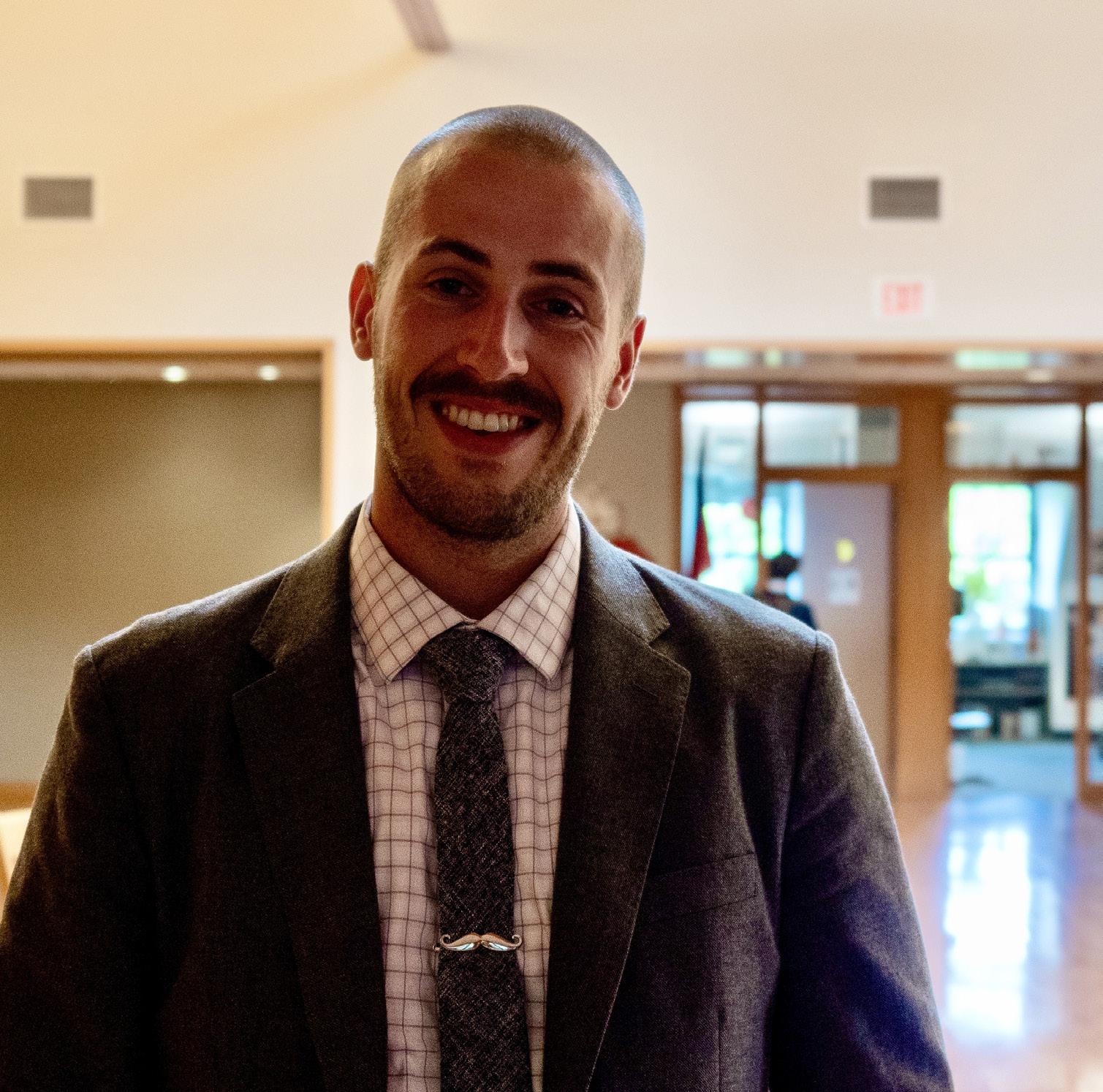
Mr. Moore holds both a B.A. and M.A. in History from Loyola University and Villanova University, respectively.
In his role, he will teach both Ancient World History and Modern World History.
“I’m excited,” Mr. Moore said. “After spending a full year substituting in all three divisions, it’s really exciting to come back and work in the upper school full time, having my own class and guys, and continuing to work with the crew guys.”
worked at Haverford for a few years.
Mr. Moore serves as an assistant coach for the crew team, a position that he has filled for two years.
Mr. Moore has also worked in the classroom, subbing in classes across the divisions, allowing him gain a lot of experience working with all ages of students and become a familiar face in the upper school to many students.
capacity to create the optimal environment for all members of the community.
“I’m sort of the daily operations person, so I’m hoping to keep everything organized, keep the office running, help [Head of Upper School] Mr. [Mark] Fifer and [Upper School Dean of Students] Mr. [Luqman] Kolade in any way I can,” Ms. Revoir said. “I think the three of us are really great at collaborating together to create a wonderful experience for the students.”
On a personal level, Ms. Revoir is looking for an ambience of comfort and assistance whenever a student walks into the upper school office, and she is eager to play her role in building that atmosphere this year.

“I am hoping that the upper school office becomes a place of warmth and welcoming, where students feel that if they have any questions or they need any help, that they feel comfortable coming to me,” Ms. Revoir said, “because that’s what I’m there for.”
Mr. Moore’s connection with students is deeply rooted for someone who has only
This year, as he takes on the mantle of a history teacher, he eagerly looks forward to guiding these same students in a different academic pursuit.
“I worked a lot with the now rising Fourth Form guys in my long-term sub role in the beginning of last year, so I had a lot of the guys in English in my sections this year for history,” Mr. Moore stated. “It will be interesting to see the guys in a different
subject.”
Mr. Moore has also worked with the rising Third Form class.
“I saw them [in middle school], so seeing them mature and take that next step will be great,” Mr. Moore stated. “I am looking forward to building off of what we started last year.”
With his time subbing, Mr.
Moore was able to gain a unique view of the school, as opposed to one division.
“As a sub, I got to see what a Haverford student was from start to finish,” Mr. Moore stated. “There were days when I started in Pre-K and would end with [Sixth Formers]. I was able to have the unique experience of getting to see how Haverford shaped boys into young men.”
the index · features September 2023 Page 8 INDEX STAFF
Ms. Corey Revoir
“I definitely see myself as a people person.”
MS. COREY REVOIR
PIERCE LAVERAN
Mr. Robert Moore
’24
Ethan Lee ’24
“After spending a full year substituting in all three divisions, it’s really exciting to come back and work in the upper school full time.”
MR. ROBERT MOORE
“I saw them [in middle school], so seeing them mature and take that next step will be great.”
MR. ROBERT MOORE
Is summer work helpful?
When summer starts, students look forward to pursuing their own academic and athletic interests, going on vacation with family and friends, and relaxing. But as June goes by, students begin worrying about summer work.
because I would stress over it, and it feels unfair that there is no gauge on how seriously some summer books need to be read over others,” Stalkamp said. “Some books I remember reading and then not being mentioned in class, however other books I would need to write a huge essay about, and then I would regret not annotating.”
Stalkamp suggested that exorbitant amounts of summer work should only be assigned in the most difficult classes.
classroom community that allows for individual students to grow as readers, writers, and thinkers,” Mr. Pariano said.
One common student criticism of summer work is the fairness of testing self-taught material. For many students, receiving a significant grade immediately on the first day of class feels unjust.
this into consideration and try hard not to pile it on, hence our selection of a single substantive text for most courses,” Mr. Pariano said.
Still, Kelly still felt that summer work stacked on top of other academic work was oppressive, especially for rising Fifth and Sixth Formers.
Students have mixed opinions on summer work: while most wish it did not exist, some see the benefits to having schoolwork over the long break.
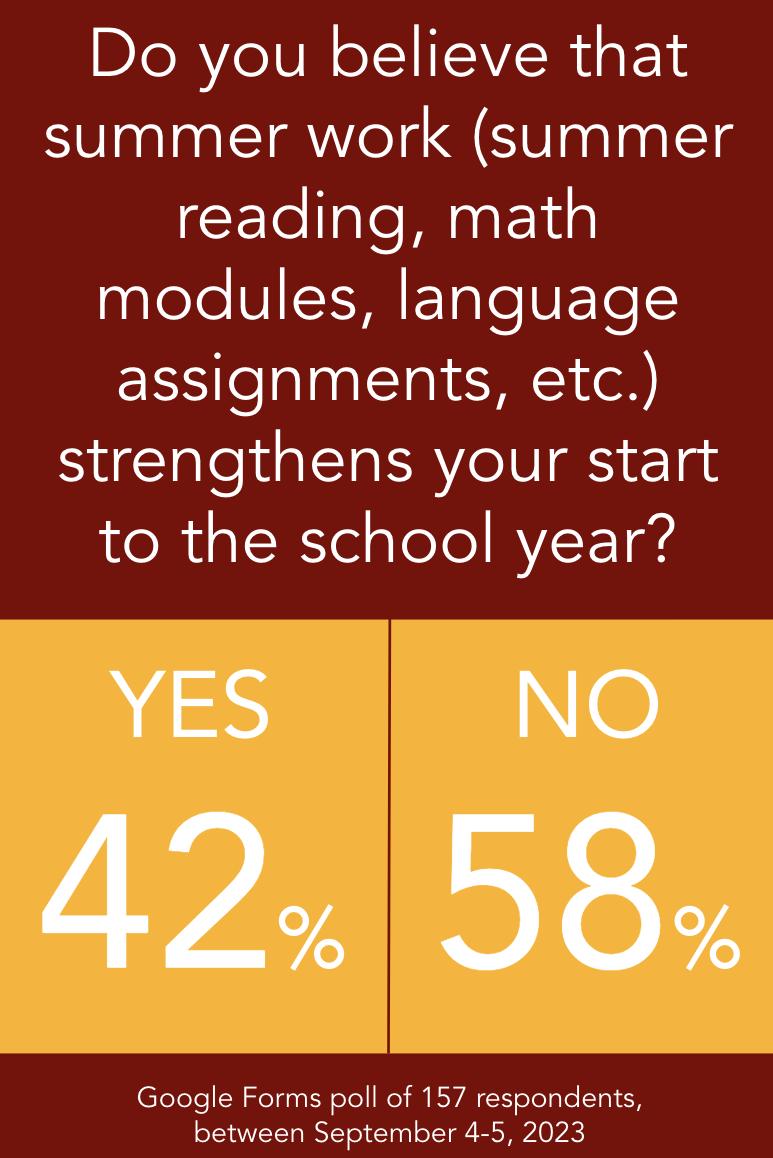
“I think summer reading is necessary, but the work given can often feel unnecessary or extraneous,” Fifth Former Finn Kelly said.
Sixth Former Brady Stalkamp shares mixed feelings about summer work.
“[Summer work] can be helpful yet daunting,” Stalkamp said. “It helps me get into the mindset for school, but can also become very stressful and annoying, when summer is a time meant for recovery.”
Kelly feels that reading books as school assignments could suck the enjoyment out of reading.
“We know it’s for school, and we have to do it or else we’ll be penalized,” Kelly said.
Stalkamp noted a lack of consistency in assignments between teachers.
“For me it’s really annoying especially
“For example, Biology Honors has you start the class well before school itself starts, which can be nice for you to get into the headspace of school,” Stalkamp said.
For teachers, summer work introduces students to their classroom atmosphere. English teacher Mr. Anthony Pariano uses summer reading to help students acclimate to the norms of the year.
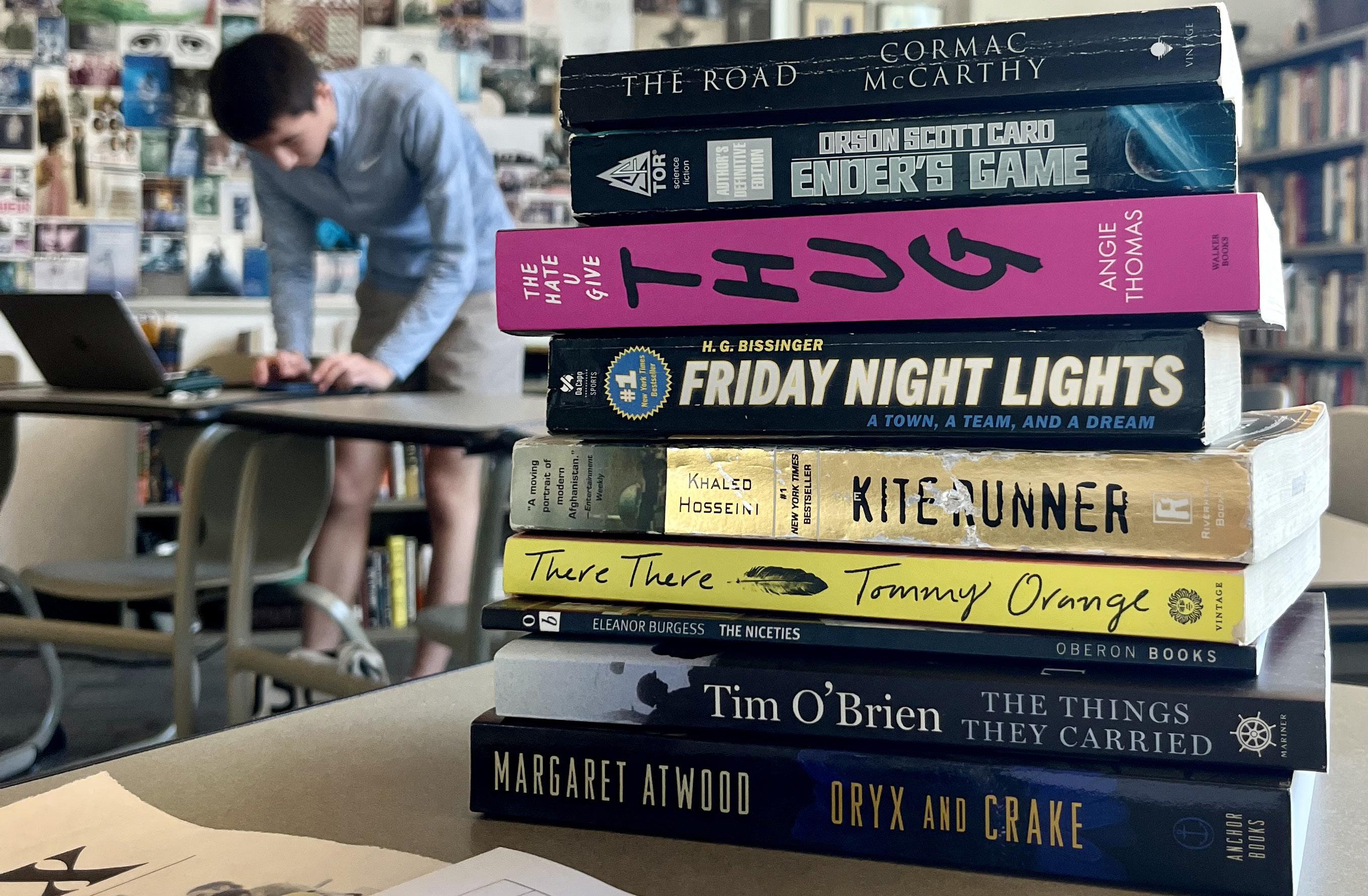
“[The summer reading books] give students a good view into the questions, themes, and challenges of the literature they’ll be encountering throughout the year,” Mr. Pariano said.
Summer work also allows teachers to begin constructing a class ethos.
“The main function of the summer reading texts is to help begin building a
Stalkamp felt that reading a textbook on his own gave the sensation of being “trapped in COVID” again, doing meaningless online school with no human interaction.
Kelly felt that there should be a refresher prior to a graded assignment.
“Teachers should spend at least a class discussing summer work before testing on it,” Kelly said.
But Mr. Pariano believes that testing students on their summer reading is beneficial.
“I do also use them as a means of assessing my students (i.e. getting to know who they are as readers, writers, and thinkers) and giving them a good idea of what assessment looks like in my class,” Mr. Pariano said.
Mr. Pariano acknowledges that some students may need time to refresh their knowledge.
“I certainly do expect students to be ready to be a part of the conversation that will ensue and continue throughout the school year, but I also understand that many students need a moment to survey the scene before diving right in,” Mr. Pariano said. “A brief grace period usually allows for students who might need a little time to reacclimate to school to dust off their books, revisit them (if they did their reading early in the summer), or — ahem — complete them.”
Mr. Pariano also recognized that large amounts of summer work could be intimidating.
“In the English Department, we take
“I think that it could be dangerous to have a huge amount of summer work for juniors and seniors because it could jeopardize other necessary parts of our academic lives like our standardized tests and college applications,” Kelly said.
Kelly, like many juniors, has spent his summer studying for the SAT/ACT.
“The work has stacked up on me for the last weeks of summer,” Kelly said. “It can be hard to see why we just absolutely need to read this or that before class starts.”
CASEY WILLIAMS ’24
Selections of the English summer reading texts
Elliot Lee ’25
“[Summer work] helps me get into the mindset for school, but can also become very stressful and annoying.”
academics the index · academics September 2023 Page 9
BRADY STALLKAMP ’24
“[The summer reading books] give students a good view into the questions, themes, and challenges of the literature they’ll encounter.”
MR. ANTHONY PARIANO
Unlocking the value of high school internships
Imagine spending the summer on the red planet of Mars… in virtual reality.
This summer, some students indulged in a vast array of internships, ranging from hands-on stem cell research to virtual 3-D recreations of NASA images.

Internships serve as bridges between the classroom and the real world. They allow students to put theory into practice, helping them navigate the complexities of the working world. Through internships, students get a firsthand look at their dream careers, providing insights that textbooks alone cannot offer.
be exposed to raw talent and young drive. According to SHRM.org, 70% of companies say that high school interns who complete their programs are either “very likely” or “completely likely” to eventually land a college internship with their company.
Bridging the gap between theory and practice, Sixth Formers Nolan McCloskey and Ryan Brewington have been hard at work this summer.
McCloskey, a long-time computer science fanatic and skilled coder, worked at Villanova University under Professor Frank Klassner.
“I used pictures from NASA’s archives to create sets of pictures that were taken by the same site on the surface that were either taken by a Mars rover or a Mars lander,” McCloskey said. “Then I created a program to stitch together those images that were from the same real-world location to create a VRC that depicts what it is actually like to be on Mars’ surface.”
Not only does this program allow viewers to see images that depict Mars, they can interact with the program.
High school students have not always focused so heavily on summer internships— this is a much more recent trend. Internships almost always come with the connotation of college or professional work, but recently, high schools have entered this field as well.
One major reason may very well be the rise of AI and technology. As the world develops, jobs will change. Gaining valuable experience as a high schooler is one step towards ensuring a job with low replaceability. According to a CBS News report, A.I. cut around 5% of the U.S. job losses in May 2023. This, coupled with the ability to contact employers or professors more easily through social media, allows more high schoolers to intern at a company.
In addition, employers see this as an opportunity to grow as well, as employers can
“To actually display this, I’m using a software called VISR,” McCloskey said. “Essentially, it’s compiled as a tour of Mars so that you can navigate around to all these different sites where the rovers and landers have been so you can get a sense of what Mars’ terrain is like.”
McCloskey chose an internship in computer science to fuel an existing passion.
“Around two years ago, I wanted to get into programming and found CS50, which is an introductory computer science class for college students that’s available online,” McCloskey said. “I worked through that in a couple of months, and that gave me a baseline of computer science fundamentals, and I was like ‘wow.’ This is actually really fun, like problem-solving, [...] it’s a lot like math, actually.”
Landing internships, however, is no easy endeavor, and both McCloskey and Brewington can attest to the struggle and
persistence that went into their summer experience.
For Brewington, using school connections like biology teacher Mrs. Kara Cleffi was helpful.
esting fields, they gained other experience as well.
“It’s a lot of cold emailing, a lot of not getting responses, a lot of getting shut down,” Brewington said. “Some advice I would give is really don’t stop, and don’t be sad if someone says, ‘I can’t take you’ because everyone is packed and busy, and you’re not just competing with other high school students. You’re also competing with undergraduates and graduates and post-docs to find these spots in these labs.”
“It’s a big commitment,” Brewington said. “I did a seven-week program over the summer, and I had to travel to Philadelphia every day. I took the train there and back. I’m basically there from 10-3 p.m. Some days even longer.”
Despite the hours and hard work, McCloskey and Brewington chose internships in fields they enjoyed. They have come away with experience and advice for the next batch of students.
“This applies to everything, but especially in CS, the more time you spend on something, the easier it gets,” McCloskey said. “At first it seems super daunting to do any of this stuff, but you can really break it down into smaller problems that you know how to solve.”
Brewington and fellow Sixth Former Ethan Lee worked at the University of Pennsylvania labs.
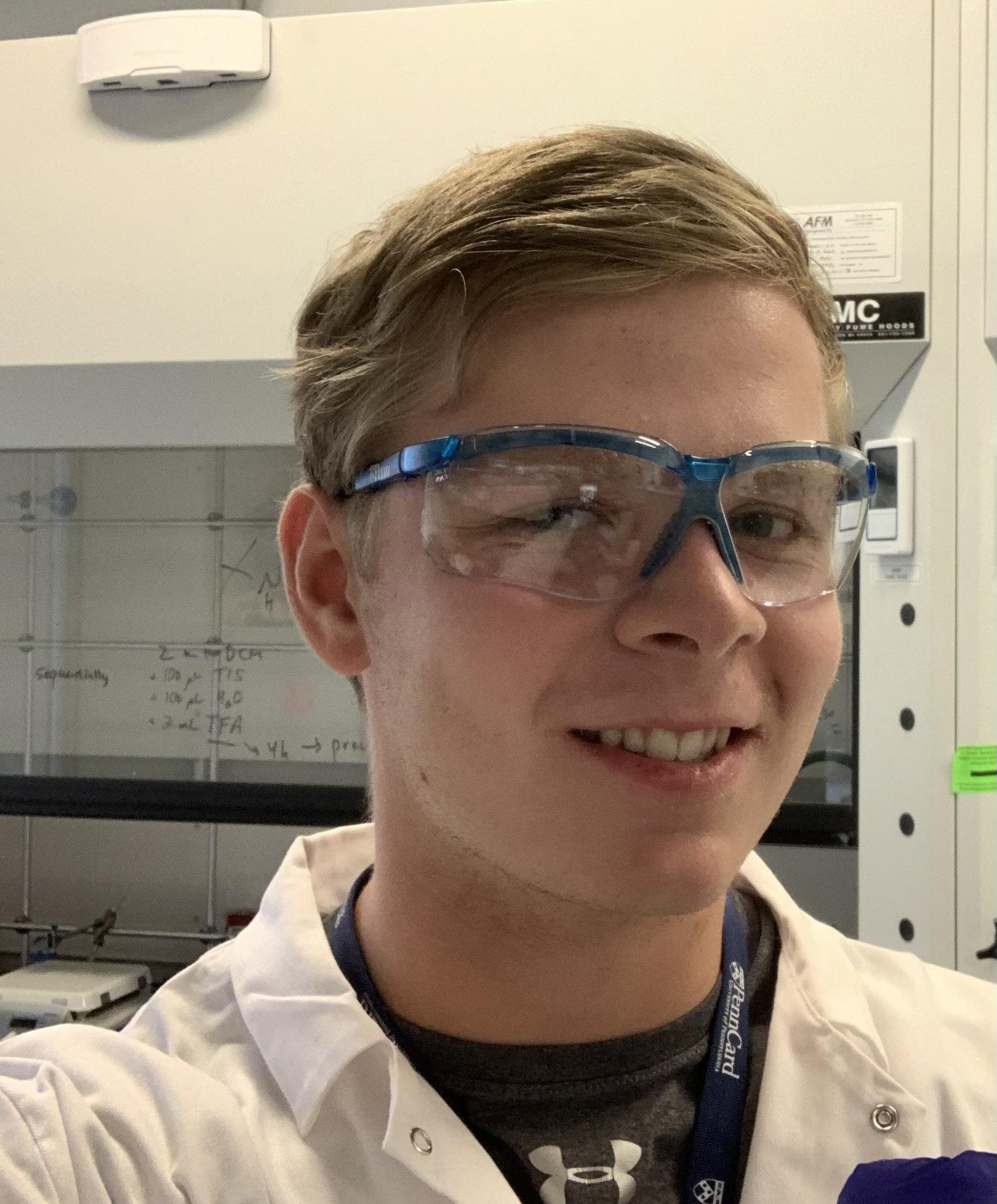
“I was in the biomaterials department of [the University of Pennsylvania], and I was working under Dr. Christopher Madl on stem cells,” Brewington said. “Stem cells have the ability to reproduce like normal cells, but they can also differentiate, which is unlike normal cells. When they differentiate, these stem cells can basically transform into almost anything, and we were looking at how stem cells can differentiate for therapeutic reasons.”
While both McCloskey and Brewington were able to gain experience in wildly inter-
Brewington gained science skills, as well as working in a lab and co-existing with other passionate members of the same field.
“I learned countless skills. I was working with graduates and post-docs, so everything they said was something new to me. You just have to be open to trying to understand things even if you don’t at first,” Brewington said. “I learned a lot about science, but also about operating in a lab with graduates and people who are just as passionate as me about this stuff.”
IRIS CAI COURTESY OF RYAN BREWINGTON ’24
Milan Varma ’25
the index · academics September 2023 Page 10
Christopher Schwarting ’24 and other young writers collaborate on a writing exercise at the Iowa Young Writers Studio, June 23, 2023
Ryan Brewington ’24 at a UPenn lab summer internship
“At first it seems super daunting to do any of this stuff, but you can really break it down into smaller problems that you know how to solve.”
NOLAN MCCLOSKEY ’24
“Some advice I would give is really don’t stop, and don’t be sad if someone says, ‘I can’t take you because everyone is packed and busy.’”
RYAN BREWINGTON ’24
“I learned countless skills. I was working with graduates and post-docs, so everything they said was something new to me.You just have to be open to trying to understandithings even if you don’t at first.”
RYAN BREWINGTON ’24
“It’s a big commitment.”
RYAN BREWINGTON ’24
While both McCloskey and Brewington were able to gain experience in wildly interesting fields, they gained other expereince as well.
neighborhood
Cabrini University closes its doors
On June 23, Cabrini University announced, through an institution-wide email, that they will cease operations at the end of the 2023-2024 school year. The campus, situated in Radnor Township, will be purchased by Villanova University.
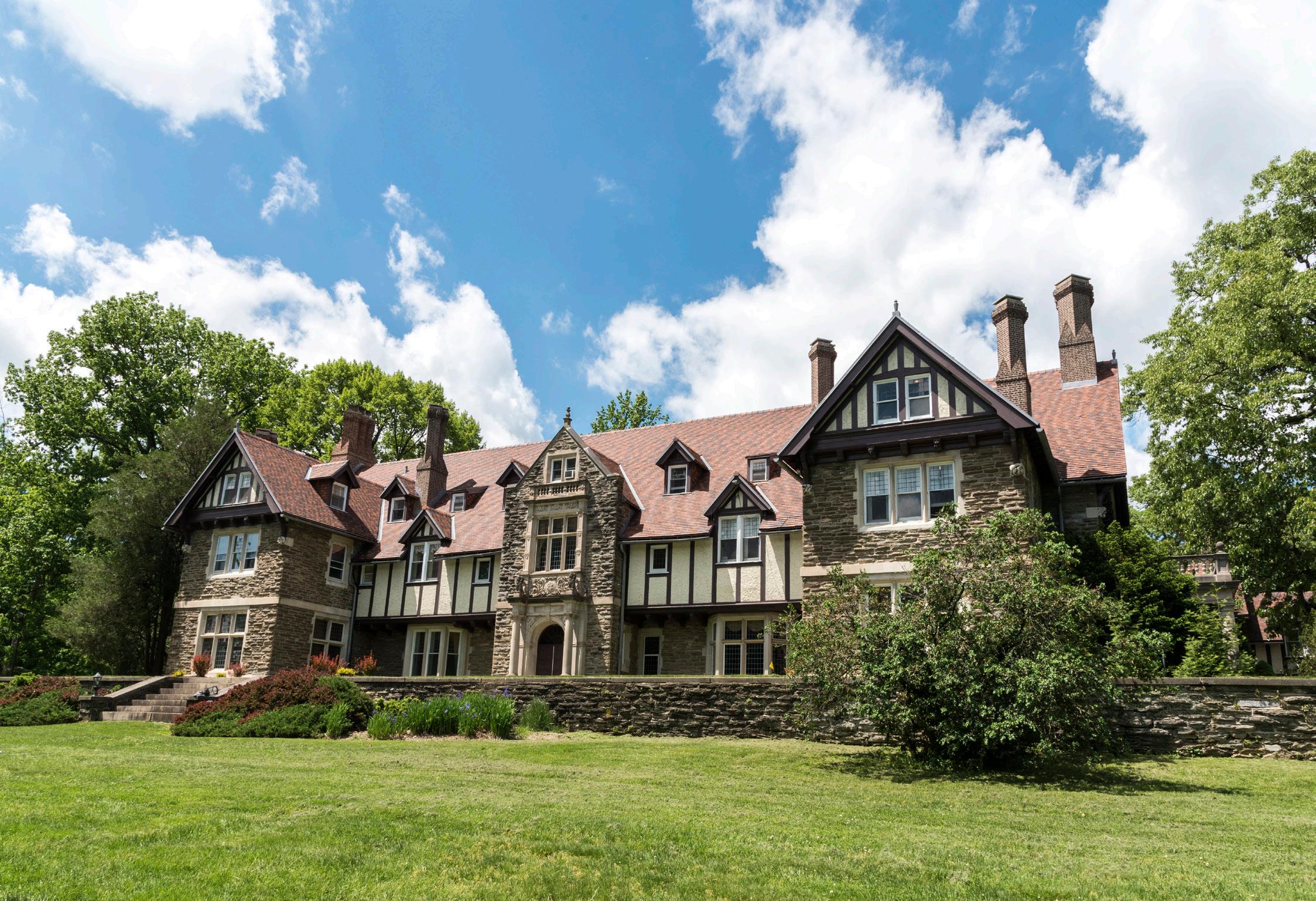
The school, founded in 1957, has a
long history with Haverford; alumni have attended the school and mathematics teacher Mr. Andrew Franz P’23 is a graduate of the institution. However, long-term financial struggles and the COVID-19 pandemic contributed to the school operating at a loss for years.
Cabrini University publicly announced
in early 2022 that they were searching for a partnership with another university. Enrollment had dwindled from 2,300 students in 2016 to about 1,500 in 2022.
In response to enrollment and financial struggles, the university implemented massive budget cuts, reducing department chairs from eighteen to eight and cutting 46
campus opinions
positions from mainly administrative roles. These cuts saved about $1 million, but it could not cover the $5-6 million deficit on their $45 million budget.
As for the 1,500 students currently on campus, their future education is not certain. Villanova University has not offered to accept all Cabrini students—they will have to apply for the fall transfer season. However, Ursinus, Holy Family, Eastern, Gwynedd Mercy, and Rosemont Colleges are offering a “seamless transition” for Cabrini students to enter their schools.
Cabrini University, founded in 1957, has a long history with Haverford.
Cabrini University is not the first college in the Philadelphia area to close or merge in recent years. This September marks the first academic year for the merger between University of the Sciences and St. Joseph’s University. Salus University was acquired by Drexel University, and will officially merge next academic year. Unlike Cabrini’s situation, Villanova did a real estate deal: St. Joseph’s and Drexel agreed to a partnership and absorbed current students.
The closures and mergers of small colleges in the Philadelphia area is representative of national trends of existential financial struggles among small institutions of higher education. Coinciding with this is increasing tuition prices and cost per student to operate an institution due to the absence of economies of scale.
Starting on a Wednesday provides a gentle return to the school year

casual clothing.
As evening falls earlier each day, the Phillies begin their push for the playoffs, and students finish the last of their summer assignments, the faculty begin to prepare their classrooms for the wave of students who will arrive in the coming week.
For these students, the return to class produces anxiety: a new school year means new teachers, a heightened workload, and an abrupt halt to summer freedom, sleep, and
While the first weeks of school are always jolting, starting on a Wednesday minimizes the shock.
While the first weeks of school are always jolting, starting on a Wednesday minimizes the shock. As the first day of class consists of meeting teachers, reading syllabi, and familiarizing oneself with one’s schedule, only two real days of typical classes take place during the first week.
Students are gently reminded of what student life is like before being sent home for the weekend.
While one may argue that beginning on a Wednesday can lead to students feeling disoriented—as the school week typically begins on a Monday—this small inconvenience is relative to the undisputed benefits that beginning classes on a Wednesday bring.
Students are adaptive, and, for the majority, this disorientation is minor if present at all.
Fourth Former Colin Toth enjoys the Wednesday start.
“It helps us get back into the swing of things after a long summer,” Toth said. “We don’t have to push through a long week of classes, but are instead eased back into the school routine.”
practical and stress-alleviating approach, as well as a cherished tradition.”
Many students share Toth’s opinion.
“Although students enjoy frequent criticism of the school’s administrative decisions,” Sixth Former Preston Wu said, “beginning school on a Wednesday is both a
 MILY ROWAN VIA WIKIMEDIA COMMONS
Cabrini University Mansion, located in Wayne, PA
MILY ROWAN VIA WIKIMEDIA COMMONS
Cabrini University Mansion, located in Wayne, PA
the index · neighborhood & campus opinions September 2023 Page 11
Tripp Ronon ’24
Grayson Morgan ’26
“It helps us get back into the swing of things after a long summer.”
COLIN TOTH ’26
In early August, Maui was hit by devastating wildfires, which destroyed thousands of buildings across the island. Over 100 people have lost their lives in what has been deemed the fifth-deadliest wildfire in recent American history and the deadliest in Maui’s history. How did this happen?
As early as August 7th, Maui experienced strong winds of up to 67 miles per hour, coupled with a severe drought. Even before the first fires broke out, the National Weather Service had warned that this combination of high winds and dry temperatures could potentially pose a massive threat of wildfires.
Just before 11 p.m., security footage at the Maui Bird Conservation Center captured a flash of light in the forest, likely caused by a fault in a power line, moments before the power shut down. Shortly after midnight, a brush fire, later known as the Upcountry Wildfire, was reported in the area, leading to the evacuation of residents.
On the very same evening, signals similar to those in the Upcountry Wildfire were observed from Whisker Labs’ electrical monitors, showing sharp drops in Hawaiian Electric’s grid in downtown Lahaina in West Maui. At 6:37 am the following morning, locals reported the first brush fire in Lahaina, and two minutes later, Whisker Labs stopped receiving any signals from their monitors. From there, everything began to spiral out of control.
opinions
Deadly Maui wildfires endanger thousands
throughout Lahaina. At 9:00 a.m., the Maui government declared the Lahaina brush fires 100% contained, even though the fires would soon reignite in the afternoon. Winds across Maui began to intensify, and small flare-ups, like the one on Mill Street, would take over an hour to be reported by Maui officials. Many also reported cars exploding in the streets, and neighborhoods becoming engulfed in flames.
As the day progressed, citizens evacuated, and traffic only grew worse. On many streets and highways like Hawaii Route 30, residents were trapped in their vehicles for hours, even as the fires consumed homes just blocks away. A few residents managed to avoid the flames by steering clear of trafficdense areas like Front Street, while others were forced to jump into the ocean. Unfortunately, some residents, like Joe Schilling in a senior center on Lahainaluna Road, were unable to evacuate in time and went missing entirely.
By 5:59 p.m., the fires had escalated. Dozens of civilians had abandoned their vehicles to seek refuge at the harbor. One individual reported to ABC News that he “waited over five hours before being rescued, three of which were spent in the water.” The next morning, Hawaii Governor Josh Green stated that winds reaching over 80 miles per hour contributed to the fire spreading at a rate of a mile per minute. The following weeks were dedicated to the search for information and survivors within the burnt areas.

By August 10th, the Lahaina fire was considered 80% contained, while the death toll had risen from six people in the evening to 55 people, a number expected to continue increasing.
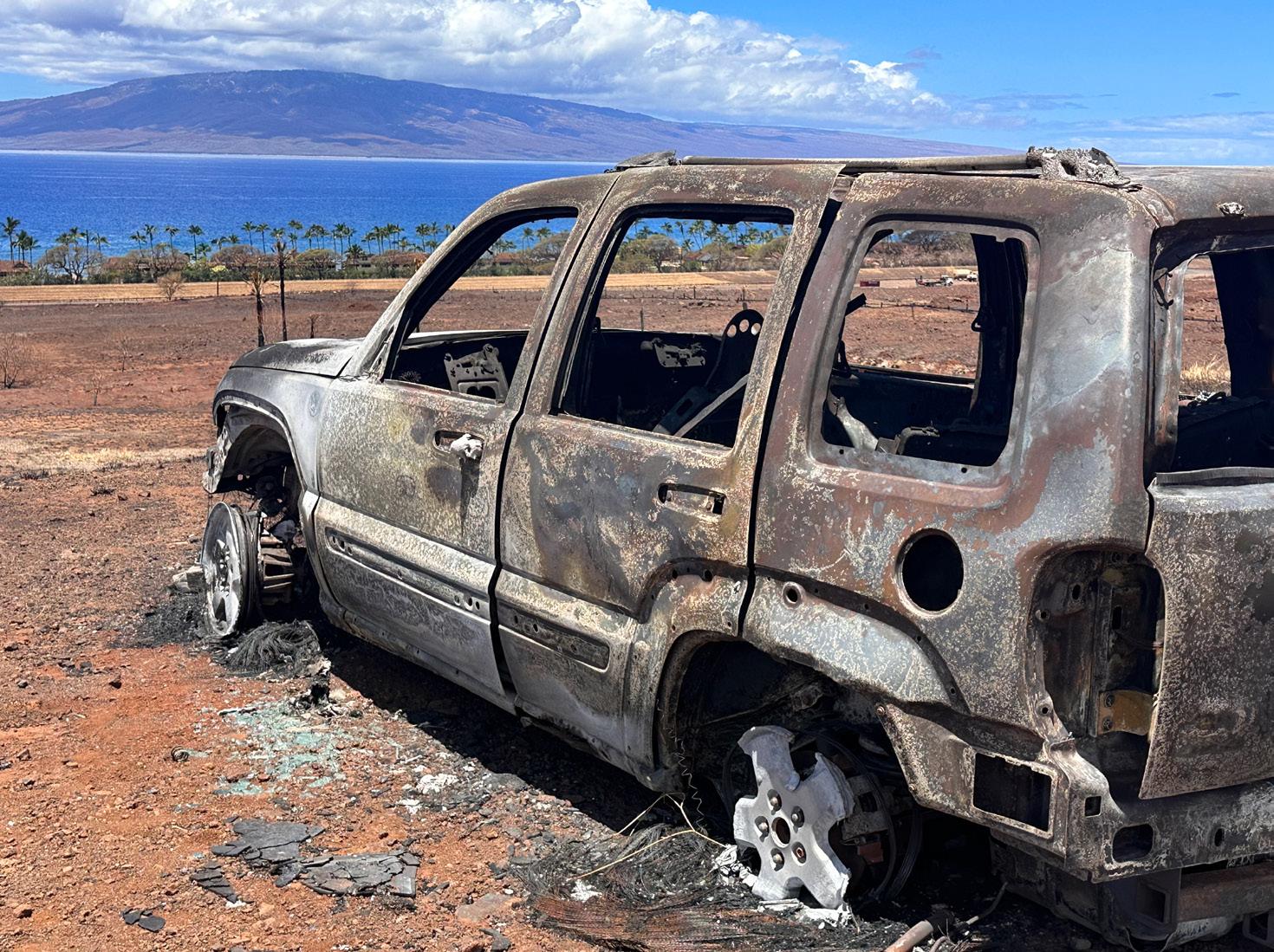
By August 13, over 2,000 structures and more than 2,000 acres of land were reported damaged or destroyed by the fires across Maui, much of which was residential. After three weeks of searching and struggling, Governor Josh Green announced that 99% of the search area had been covered, but according to The New York Times, Green had
“acknowledged that some of the deceased may never be found or identified.”
Even after Maui officials recently released a list of 388 people reported missing or dead with contact information, similar to the aftermath of Hurricane Catarina or the September 11th terrorist attacks, The New York Times stated that “it can take months or even years of forensic analysis and DNA testing to identify the deceased.”
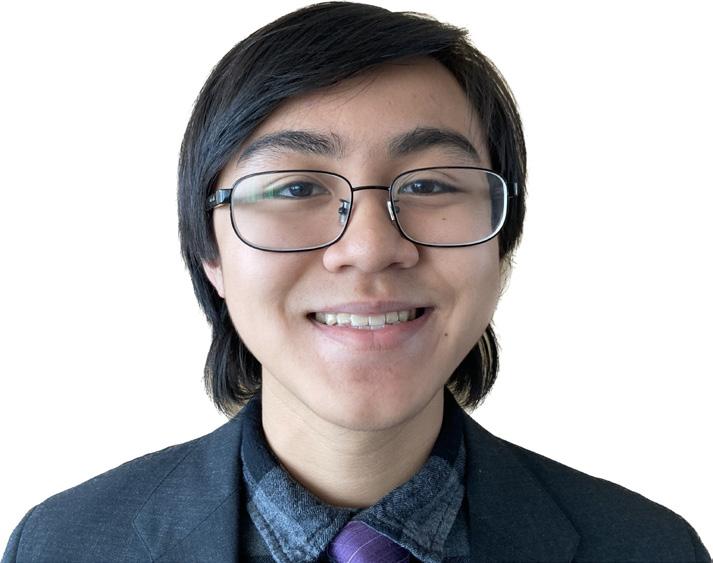
Hawaiian Electric had also been sued by Maui officials, claiming that poorly managed power lines were the cause of the fires, although the cause of the flames in Lahaina in the late afternoon remains uncertain. What is certain, however, is that Maui experienced intense weather conditions that made wildfires extremely prone to spreading.
addressed the wildfire danger beforehand.
The New York Times further reports that there was hardly an organized evacuation, with many residents not receiving emergency warnings. With power down in many areas and smoke too thick for people to see through, it quickly became impossible for people to evacuate safely. Interviews and stories from ABC News describe survivors extinguishing brush fires themselves or evacuating neighbors, with family members vanishing and not reappearing for days. The fires had disrupted electrical and communication lines, and before anyone could get in touch with each other, the fire had engulfed Maui.
Most egregiously, there were no warning sirens sounded, despite having sirens available from Hawaii’s “all-hazards warning system.” One official in charge of the sirens stated that the sirens were primarily used for tsunamis and that if the sirens had been activated, locals might have fled inland. Regardless, the official faced widespread criticism from Maui residents and later stepped down due to health issues.
The aftermath of the incident is far from pretty. Total damages were estimated at over five billion dollars, with some areas experiencing 96% of fire damage in residential areas. Many residents are currently living in hotels until the damages are addressed. Maui officials have provided limited information about some of the causes of the flames, but according to Elizabeth Pickett of the nonprofit Hawaii Wildfire Management Organization, “All these things—they’re pieces. But it’s not telling the whole story of how it got so bad.”
Pickett goes on to say that it was not an issue of emergency management but rather a lack of resources. Maui only has around 60-70 firefighters in service at any given time, and given that Maui stretches over 700 square miles and the sheer scale of the fires, it was impossible for such a small force to do much as the fires erupted. Even as conditions for wildfires worsened, Maui officials hardly
The incident was an incredible tragedy, but in some ways, it cannot be called unexpected. Many factors within Maui’s emergency management contributed to the wildfire chaos, and even now, Maui is struggling to recover. One can only wonder how much damage could have been prevented with more caution and foresight from Maui officials. It’s difficult to predict what will happen to Maui in the future, but for now, we must hope for the safety and well-being of Maui residents and hope that greater caution is exercised in the future.
Tragedies like these should serve as a warning to any community to be cautious and deliberate with the way we protect ourselves, and not just in natural disasters. Rapid communication to the community at large is a must, and the community must be informed on what to do and where to go in the event of an emergency. Even a small fire can turn deadly, like it did for Maui.
Dozens of residents reported and recorded fallen power lines, smoke, and flames
Car burned in Lahaina, Hawaii, August 15, 2023
STATE
the index · off-campus opinions September 2023 Page 12
Sean Ngo ’24
FARM VIA WIKIMEDIA COMMONS off-campus
Dozens of residents reported and recorded fallen power lines, smoke, and flames throughout Lahaina.
The aftermath of the incident is far from pretty.
August 8th, 2023 COAST GUARD VIA WIKIMEDIA COMMONS
Lahaina damage,
The history of “Summertime”
“Summertime, and the living’s easy.”
Artists have sampled and interpreted these lyrics from George Gershwin’s jazz piece “Summertime” for almost a century. From Ella Fitzgerald and Janis Joplin, to Sublime and Lana Del Rey, the effect of this song can be felt in pop culture over decades.
What once started as a jazz song in blackface minstrel shows is now sung by teenage girls. Not only have the singers associated with the song changed, but the location as well. From the South to the “L.B.C.”, the migration of a song brings with it a new audience and, likewise, a new sound.
Originally produced for the 1935 opera Porgy and Bess, “Summertime” romanticizes Southern living through a soothing lullaby. Gershwin wanted to create his own AfricanAmerican spiritual song to be included in the sound of the opera. Within the context of late 1920s and early 1930s blackface minstrelsy, Porgy and Bess instead featured a cast of classically trained Black singers. The opera was performed on Broadway and lasted 124 shows. It was later revived in the 40s and made its way on a European tour, until it was forcefully shut down by the Nazis.
Within the context of late 1920s and early 1930s blackface minstrelsy, Porgy and Bess instead featured a cast of classically trained Black singers.
With a soulful voice, singer Ella Fitzgerald twenty years later released a recording of “Summertime” with Louis Armstrong. This single has since been certified “silver” by the British Phonographic Industry.
The most well-known version is Janis Joplin’s live cover from 1969. Joplin made
the song her own by accentuating each and every syllable. Her raspy voice is uncanny in its ability to tell such a simple narrative.
With each recording, the song has adapted to its contemporary musical trends, and perhaps more palatable to white audiences with each release.

“Bradley’s on the microphone with Ras M.G./All people in the dance will agree that we’re/Well qualified to represent the L.B.C.”
A long way from South Carolina, just outside of L.A., lies Long Beach, California. Home to the musical genre of “Cali Reggae,” Long Beach is the birthplace of the band Sublime. Formed in the early 90s, Sublime took reggae songs and repurposed them. They kept the reggae beat but used post-grunge-punk instrumentals to match. Their new sound gained an underground following in the L.B.C. area and landed them a record deal with Skunk Records. It was on their final album together, the self-
Made in America 2023 canceled
After much anticipation and with only a few weeks until the show, organizers cancelled Philly’s 2023 Made In America. Originally started by JayZ, the Made In America music festival has been hosted since 2012, aside from 2020, of course. This festival has grown into a highlight of many Haverford students’ high school experience, so its cancellation came as a shock.
The festival, scheduled for September 1-2 on the Benjamin Franklin Parkway, was suddenly called off in a statement published across multiple social media platforms.
“Due to severe circumstances outside of production control, the 2023 Made in America festival will not be taking place.”
This is all they said, aside from the fact that they look forward to next year’s festival and that all tickets will be refunded.
This year’s lineup was set to include headliners SZA and Lizzo, along with Metro Boomin, Latto, Doechii, Lil Yachty, and more.
Sixth Cormer Chase Nelson expressed his disappointment.
“I feel it was really unruly, and I was really hyped to see SZA,” Nelson said.
For Nelson, it was his last year to see the festival.
“I won’t be able to see it next year ‘cause I’ll be in college,” Nelson said.
Other students felt differently about the cancellation.
“I honestly was relieved. I spent most of the summer worrying about saving up for the tickets, so when I heard it was canceled, I was a bit thankful,” Fifth Former Aaron Bonaparte said. “There were some artists like Doechii and SZA who I wanted to see, but I can figure out a different time to see them.”
The reason for the festival’s cancellation is unclear, but many theorize that it could be due to headliner Lizzo’s recent scandal.
A week prior to the festival’s cancellation, many of Lizzo’s former dancers sued the singer, claiming sexual harassment, body shaming, and a hostile work environment. This seemed unexpected, as Lizzo has been a clear advocate for body positivity in the past, but it could be a valid reason for the festival to be canceled.

titled Sublime, that they released their hit song “Doin’ Time,” which tells the story of a fated relationship between a man and a woman. The woman in this case is a metaphor for band member Bradley Nowel’s heroin addiction.
band who blended ska, reggae, and punk gained popularity through their interpretation of what was considered “Black music,” along with their largely white audience’s fascination with the “new noise.”
This “new noise” has attracted white audiences in recent decades.
Lana Del Ray, who released a cover of “Doin’ Time” in 2019 as a single for her sixth studio album Norman F*****g Rockwell (NFR), made it uniquely her own. The video that accompanied the song was a parody of the movie Attack of the 50-Foot Woman and features a fourth-wall break.
The song samples the Gershwin melody, including the leading lyrics. It brings with it hip-hop type beat as well as a coastal-reggaeinspired sound. Sublime, an all-white band
In a Rolling Stone magazine interview with Bud Gaugh of Sublime, Bud said that the “smoky, sexy, and iconic sound of her voice breathes new life into one of our favorite singles.”
If a cool, laid back, summer beat is what one is looking for, Lana Del Ray’s cover just might be sublime.
Russell Yoh ’24
DAVID LEE VIA WIKIMEDIA COMMONS
Liam French ’25
Lana Del Ray at Irving Plaza, 2012
PETER CRUISE VIA WIKIMEDIA COMMONS
Lizzo and backup dancers in a 2018 concert
If a cool, laid back, summer beat is what one is looking for, Lana Del Ray’s cover just might be sublime.
arts the index · arts September 2023 Page 13
Water polo looks to continue tradition of success
The water polo team is no stranger to success. In 2022, they finished 19-3, and they seek an improved end-of-season record this season.
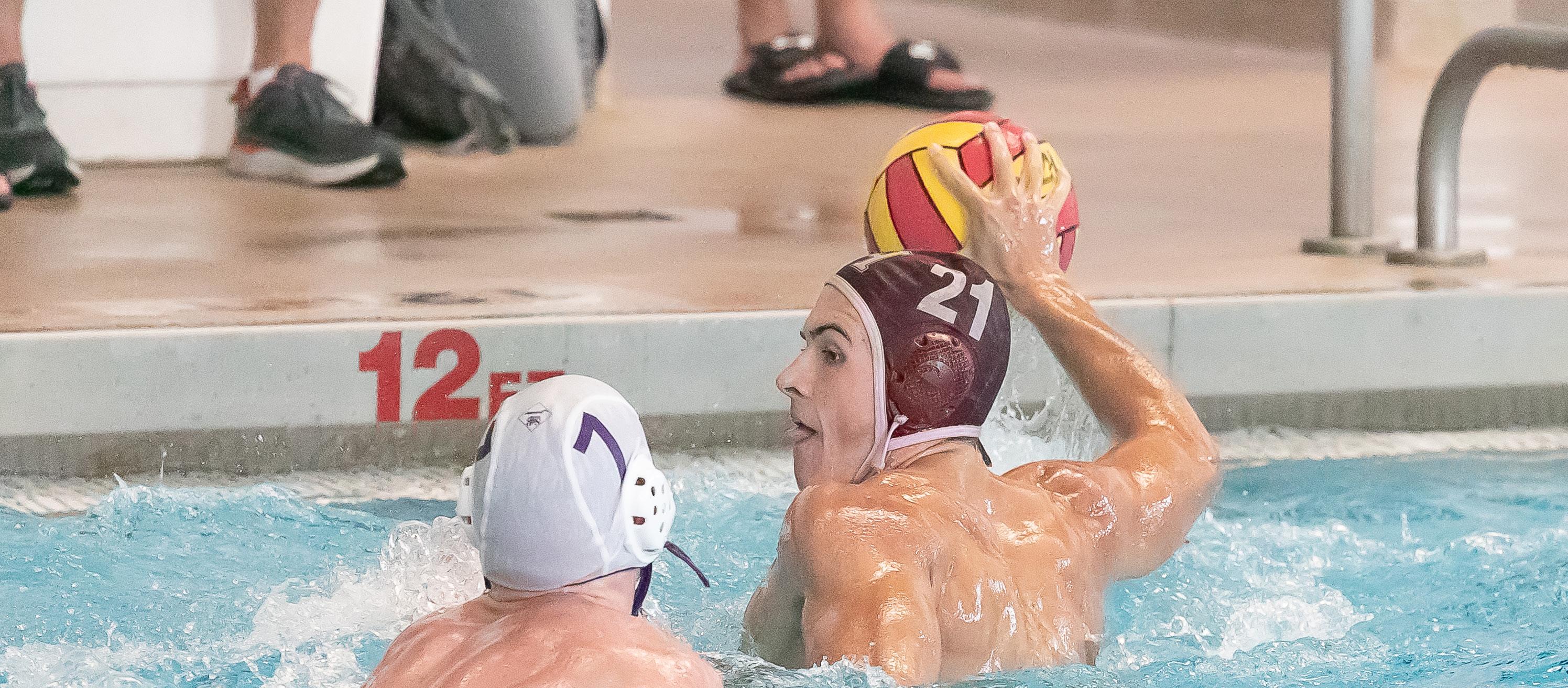
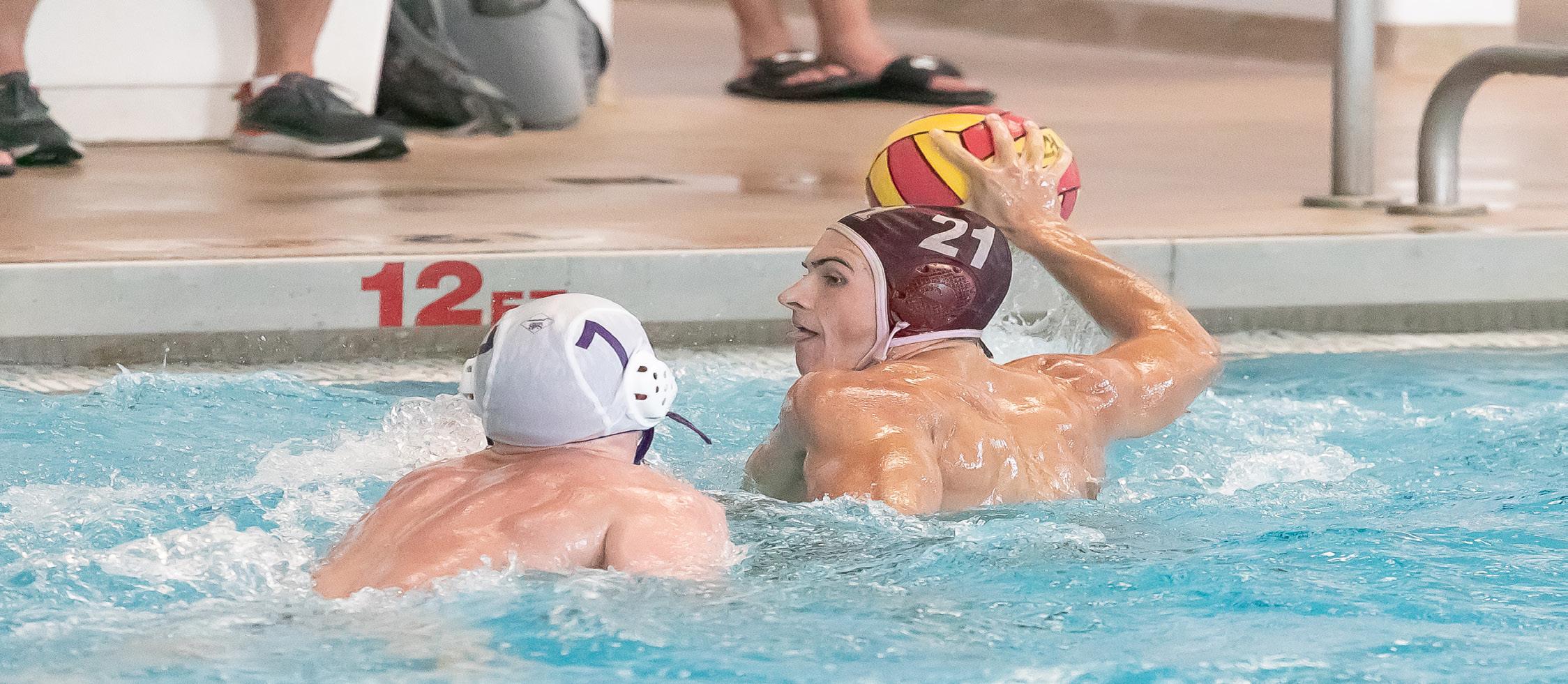
The team is also eyeing some big titles.
“The expectation that we have set for ourselves is to win the Inter Ac. As Inter Ac champs five years in a row, we see this as our standard,” Sixth Former Luke Putter said. “Our main goal for the season is to bring home an Easterns Championship. We have been runner-ups at the tournament the last two years, so our main priority for this season is to finally make that championship a reality.”
Fifth Former Zach Dixon said, “While team goals are vital, more notably each player on our team has their own personal goals.”
From technical skills to attitude in the pool, individual improvements support the team’s development. Personal objectives aside, physicality is a team value that each player is expected to uphold.
“Preseason always starts with two weeks of four-hour long practices that consist of three hours of pool time and one hour of dryland,” Fifth Former Henry Pennington said. “Earlier in the summer, we emphasize conditioning so that we have no trouble physically during games.”
Dixon added, “Our coaching staff made it quite clear that each player should take time to get/stay in shape throughout the summer leading up to preseason.”
Although the team is always looking to
improve, and preseason does involve some basic skills training, the team is advantaged by its players’ years of experience.
Because of the many hours that the group has put in together throughout the years, they have formed close bonds.
“As a team, we are practically family,” Dixon said. “Support is big on our team. We make sure we hold each other accountable.”
Beyond accountability, the team’s culture also creates unique bonds.
“I would say that the water polo team
“We are brothers in and out of the pool and because of that, we are able to stick together as a team even in our toughest moments, and that philosophy has contributed to our success year after year,” Pennington said.
With a respected coaching staff, the team finds itself with a consistently strong player pool.
“When looking at a couple of years of success, you can maybe attribute that to a few players, but when you extend that time period longer and longer the success can only be attributed to the coaching staff,” Putter said. “Players come and go every year, but the coaching staff is what remains constant.”
With players stepping up to fill the spaces left by graduates, the team is ready to continue its tradition of success.
“Coach Kevin Van Such has encouraged many of us at a young age to try the sport and has been a crucial factor in developing us as athletes,” Pennington said. “Haverford has a culture of athletes who are committed to staying in shape, and we have a lot of amazing swimmers at our school too who also get involved with the team.”
has some of the greatest chemistry that I’ve seen,” Putter said. “If you look at our six starters, we have all been playing together for a minimum of seven years. Experience together like that creates a connection that is tough to match up against.”
The team’s culture also allows for strength through adversity.
Fords golf thrives under new leadership
Coming off of a major win against St. Joe’s Prep, the Fords golf team now sets their eyes on the InterAc, a state title, and EA Day. While the roster is made up of experienced, returning players, the team is under new leadership in the hands of Third Form Dean Mr. Stephen Cloran, and Sixth Form Captains Quin Bongiovanni, Alex Nemo, and John Rouse.
“I’ve been coaching team sports for most of my professional life, and I have to say that [the captains] have been extraordinary as program leaders,” Mr. Cloran said. “I am not surprised at all though, as I have known them for more than a few years now. I’m quite fortunate and so grateful to have such strong captains.”
The team’s success hasn’t just been about skill; it’s also about the camaraderie and culture they have built. Whether it’s playing casual rounds, sharing team dinners, or competing together, the team maintains a strong emphasis on both competitiveness and unity.
“For me, the team culture is really what makes this team so special,” Bongiovanni said. “Unlike other sports, where there may be a divide between underclassmen and upperclassmen, we all stay together on Haverford Golf. We’re all brothers and will always push each other to be better.”
The team has set ambitious goals for the season: winning the Inter Ac, beating EA, winning the state title, having the highest GPA of all the sports teams, and making the
world a better place through a service learning project.
Beyond these objectives, they also prioritize maintaining integrity and respect for the game.
“A Haverford golfer will always play, and
“We all just got back together and are getting ready to step into the shoes of big players like Bram Schork [’22] and Luka Sekulic [’23] who have had big roles in the previous years for the team,” Pennington said.
The new squad has already proved its dominance: they recorded a 20-3 win over Landon School on August 24 to open their fall season.
enforce the game with complete honesty and respect,” Bongiovanni said. “A Haverford golfer should be nothing shy of a gentleman at all times, and there absolutely no room for any disrespect to the game which has given us so much.”
 Despite the new faces leading the team, the transition has been nothing but smooth.
Despite the new faces leading the team, the transition has been nothing but smooth.
Arsh Aggarwal ’24
COMMUNICATIONS
Ian Rosenzweig ’25
MS. DEB PUTTER
Henry Newhall ’24 in last year’s early contest against Mt. St. Joseph’s
Gregor Weissenberger ’25 surveys his shot in last year’s EA Day
“Players come and go every year, but the coaching staff is what remains constant.”
LUKE PUTTER ’24
“Our coaching staff made it quite clear that each player should take time to get/stay in shape throughout the summer leading up to preseason.”
sports the index · sports September 2023 Page 14
ZACH DIXON ’25
“We are brothers in and out of the pool and because of that, we are able to stick together as a team even in our toughest moments, and that philosophy has contributed to our success year after year.”
HENRY PENNINGTON ’25
“Unlike other sports, where there may be a divide between underclassmen and upperclassmen, we all stay together on Haverford Golf.”
QUIN BONGIOVANNI ’24
Soccer, cont. from front page
“The only way to stay game-ready is to get consistent reps in, so I play club and train with other teams any chance I get.”
The bond the team shares to be able to train in coordination together in their own free time demonstrates just how they operate.
Every year, incoming freshmen and JV members are introduced to the team.
“What I found is that the freshmen this year are just great guys in general,” Kaplan said. “I think they’ve just folded into the team really nicely.”
Older players also act as mentors for younger guys, both on and off the field.
personal goals on how to get better and be a better teammate in general.
“Last year I finished team MVP along with Cresswell, so hopefully I can build off that season,” Kaplan said. “I was also watchlisted for high school All-American, so hopefully I can get that down as well.”
Cresswell has similar goals.
Kaplan and Cresswell have gone through what many will experience in the struggle to become a captain and maintain that role, but most of all, build up the next set of talented players.
“I’m trying to foster a culture where everyone is held accountable by everyone and where upperclassmen can take freshmen and sophomores under their wings,” Kaplan said.
Of course, every player on a team has
“My personal goals are to repeat winning the Inter-Ac and just ultimately help my team win all the games we have on schedule,” Cresswell said. “I’m also striving to hopefully get the All-American honor which has always been a dream of mine.”
Leaders are built by experiences, but also by lessons learned and imparted from previous leaders.
“Take on an important role on the team now,” Cresswell said. “Always do your part and be accountable for your actions.”
The message of drive and confidence is echoed throughout the captains of the team.
“Don’t be afraid to reach out. If you’re a freshman or sophomore or junior, if you’re stepping up and being a leader, just within your own class, I think you’re setting yourself up really well to be a captain or a leader senior year,” Kaplan said.
Fords Football falls to Imhotep, look to stengthen “push”
On the first Friday night of September, the Fords fell to Imohtep Charter by a score of 35-0. The game was played as a part of the Mid-Atlantic Pigskin Classic, which featured multiple games each day over Labor Day Weekend.
Despite the final score, the Fords started well against Imhotep, winning the coin toss and electing to defer. After quickly forcing a three-and-out on the Panthers opening drive, the Fords got the ball around midfield. If not for a holding call on a 20-yard rush by Sixth Former Matt Brosko, the Fords would have been near the redzone. Ending up behind the sticks meant the Fords had to punt the ball back to Imhotep.
The first punt Fourth Former Ian Gopez took as a starter for the Fords was a great one—downing the Panthers inside their own one-yard line. In spite of that, the Panthers proceeded to shift the current—walking the ball to midfield before capping the drive
off with a 48-yard touchdown pass over the middle of the field.
The patented “push” the Fords offensive line got last year to contribute to their dominant running game was lacking against Imhotep.
With Matt Pante and Sean Dugery now in college, the Fords offensive line was weakened coming into the season. This manifested itself in the clear struggles the Fords had to make any gain on first down, which was in deep contrast with last year, where the Fords could consistently pick up four-to-six yards on first down.
Early on, Coach Isander saw the Fords struggle to create holes up the middle of the field—with Imhotep stacking the box heavily.
The Fords then attempted to start running the ball off tackle, and while they experienced some success, they also at times struggled to seal the edge, losing yards. These
struggles on first down put them behind schedule and forced them into constantly uncomfortable third-and-longs with passes from first-year starter Fifth Former Mac Gaffney.
The struggles only worsened as the clock crept towards halftime with Imhotep scoring twice in a four-minute span with about six minutes left in the second half.
Down by a margin of three touchdowns at the half, the Fords came out of a delayed halftime and continued to struggle on offense. The Panthers had their second interception of the night about halfway through the third quarter to set up their fourth touchdown of the night. From there on, the Fords continued to struggle to move the ball the rest of the night.
Imhotep would score once more in the dying embers of the game to win in a convincing fashion.
The Fords ended last year ranked #2,
in MaxPreps Pennsylvania football rankings and dropped to #11 in the preseason rankings. With Imhotep’s numerous Power-5-Conference-committed players and strength in depth—they were ranked #2 to begin the season. The Fords losses of All-Inter-Ac defenders Louie Atkinson, Ryan Getz, Wills Burt, and Inter-AC MVP Billy Brosko meant there was always going to be a transitionary period as underclassmen found their footing at the varsity level.
The Fords now look ahead to hosting Academy Park before a visit to La Salle, who dropped their season opener to Malvern 13-7 in Ocean City.
Playing their traditional ten-game schedule, the Fords will finish out their nonconference action away to Garnet Valley and home to Upper Darby. From there, the Fords will have a bye week to prepare for their season opener at Germantown followed by their meeting with Malvern Prep.
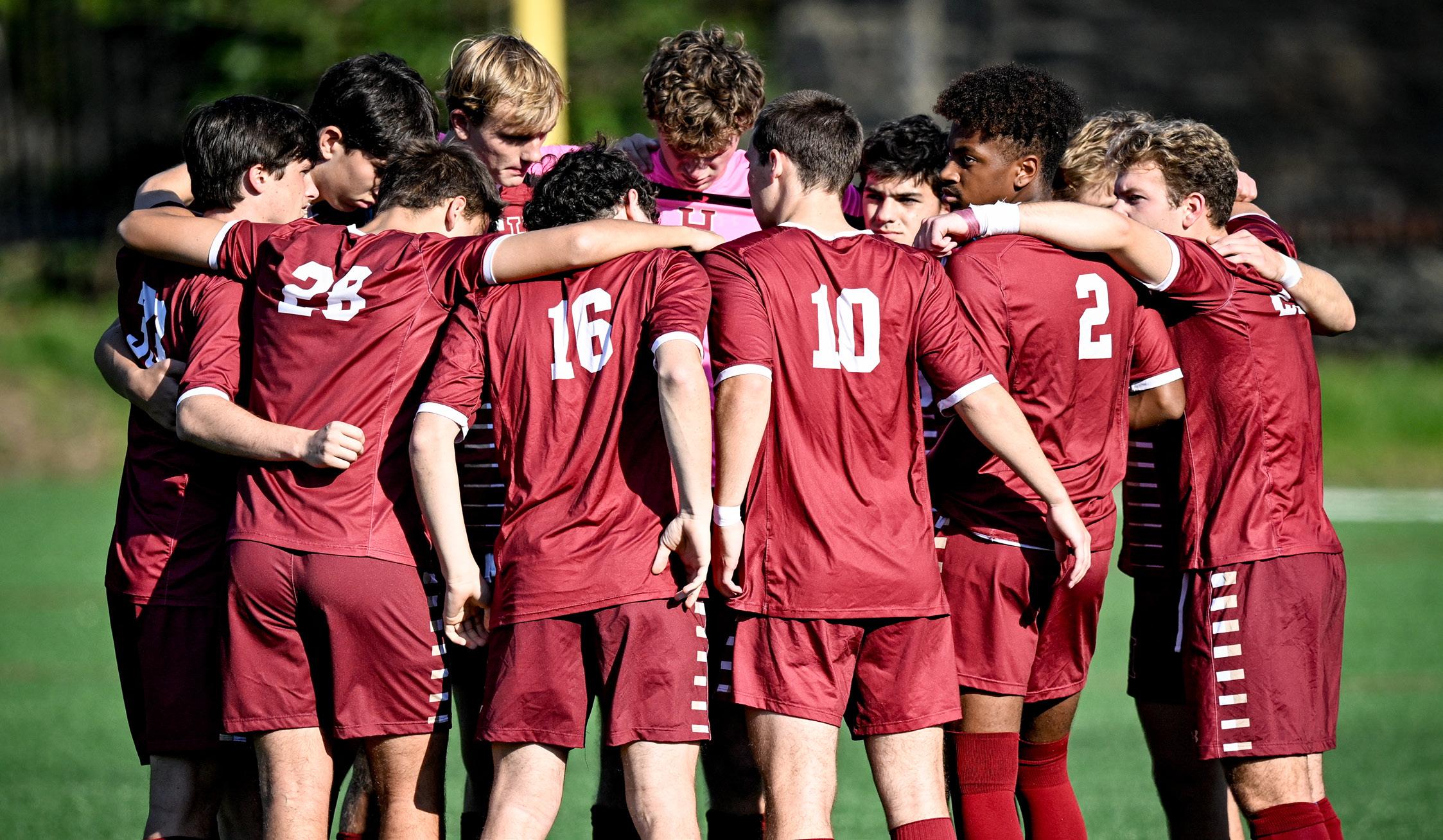
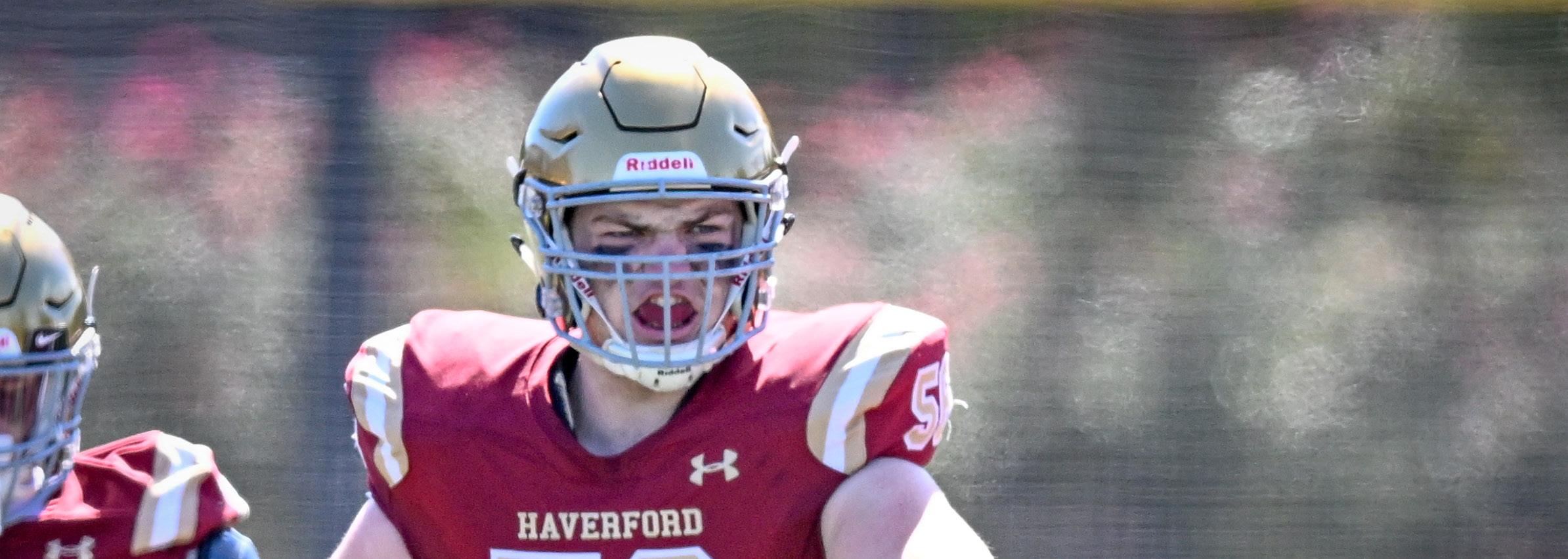
DR. MIKE NANCE
Last year’s soccer team before a 1-0 win over Penn Charter last October
the index · sports September 2023 Page 15
Guard Thomas Barr ’25 in action, last September
“I’m trying to foster a culture where everyone is held accountable by everyone and where upperclassmen can take freshmen and sophomores under their wings.”
THOMAS KAPLAN ’24
Charilie Keidel ’24
“My personal goals are to repeat winning the Inter-Ac and just ultimately help my team win all the games we have on our schedule.”
DR. MIKE NANCE
CONNOR CRESSWELL ’24
Cross Country builds strength for competition and community


Alex Dardarian ’25 leads the pack at last year’s EA Day
Building on a tight community fostered last season, the cross-country team returns excitedly for healthy competition and communal spirit. This fall, traditional Sixth Form leadership takes on a new form, with the only Sixth Former, Nolan McCloskey, captaining alongside Fifth Formers Will Suter and Finn Kelly. With Mr. Brian Long returning for his second year as head coach, all are ready to start the season.
Preseason training began two weeks ago, setting expectations and preparing athletes for soon-approaching meets.
“We’ve been running every day,” McCloskey said. “Coach Long sets our running program. For example, a week might consist of three steady runs, two workouts, an easy day, and a long run—an hour and fifteen minutes of running which usually equates to about 10 miles.”
With fewer upperclassmen on the roster, the team has relied on splitting into two cohorts.
“Because of the difference in workload, the coaches made the difficult decision to split up the A squad and B squad guys a bit more this season,” McCloskey shared. “Both groups do some of the warmup and cooldown together, but run independently.”
While permitting younger and newer runners to optimize their training, split practices limit team bonding.
training.
“We’ve been running whole-team activities after preseason practices, such as playing wiffle-ball or going out to get food,” McCloskey said. “As the school year starts, it’s important that the older guys talk to the younger members of the team outside of practice, even if that just means saying ‘hi’ in the hallways,” McCloskey said.
In the switch to school year practices, the team is stressing good habits.
“Up through the first few meets of the year we’re much more concerned with getting in the best possible shape we can for the back-half of the season,” McCloskey said.
“I think everyone is excited to compete and show off the results of the summer and pre-
season work. Personally I’ve been making sure that I’m stretching sore areas, drinking enough water, eating enough protein, and getting enough sleep so that my body can recover well. We try to stress these things as they really do make a difference.”
Team leaders expect the commitment to rigorous training to yield results, setting goals for strong performances in upcoming competitions.
McCloskey said, “The cross-country team is looking the most competitive it has in quite a while. We have many great runners on the team, and we are looking forward to placing well at meets, especially at the InterAc Championships which is always the one of the biggest and most exciting races of the

seasons, and of course at EA Day.”
Specific competitions from last year motivate the team’s performance in certain meets.
“A specific team we have our eyes on is Penn Charter. They just barely beat us at Inter-Ac’s last year, but I think that we’ll have them beat by the end of this year,” Kelly said.
The team will compete at its first meet on September 12th. As they grow more competitive, so too does their bond.
“I think the vibes this year are great, and it only takes one look at the team before practice to realize that,” McCloskey said. “The team has a very bright future with nearly everyone on the team still having at least another year after this season.”
“Preseason is the first chance we get to build a team with a strong community that leads us through the year,” Kelly said.
To promote team brotherhood, leaders have introduced other activities outside of
Christopher Schwarting ’24
“Preseason is the first chance we get to build a team with a strong community that leads us through the year.”
FINN KELLY ’25
the index · sports September 2023 Page 16 COMMUNICATIONS COMMUNICATIONS
Michael Crutchlow ’25 in action in last year’s EA Day
























 CONNOR SIMPKINS ’25
Mr. Damian Long in the college counseling office, August 31, 2023
CONNOR SIMPKINS ’25
Mr. Damian Long in the college counseling office, August 31, 2023








 MILY ROWAN VIA WIKIMEDIA COMMONS
Cabrini University Mansion, located in Wayne, PA
MILY ROWAN VIA WIKIMEDIA COMMONS
Cabrini University Mansion, located in Wayne, PA







 Despite the new faces leading the team, the transition has been nothing but smooth.
Despite the new faces leading the team, the transition has been nothing but smooth.




